Business Operations Report: ALDI's Organizational Analysis
VerifiedAdded on 2020/10/22
|20
|6692
|358
Report
AI Summary
This report provides a comprehensive analysis of ALDI's business operations. It begins with an introduction to business operations and then delves into ALDI's organizational functions, including production, finance, human resources, sales and marketing, and research and development, along wit...
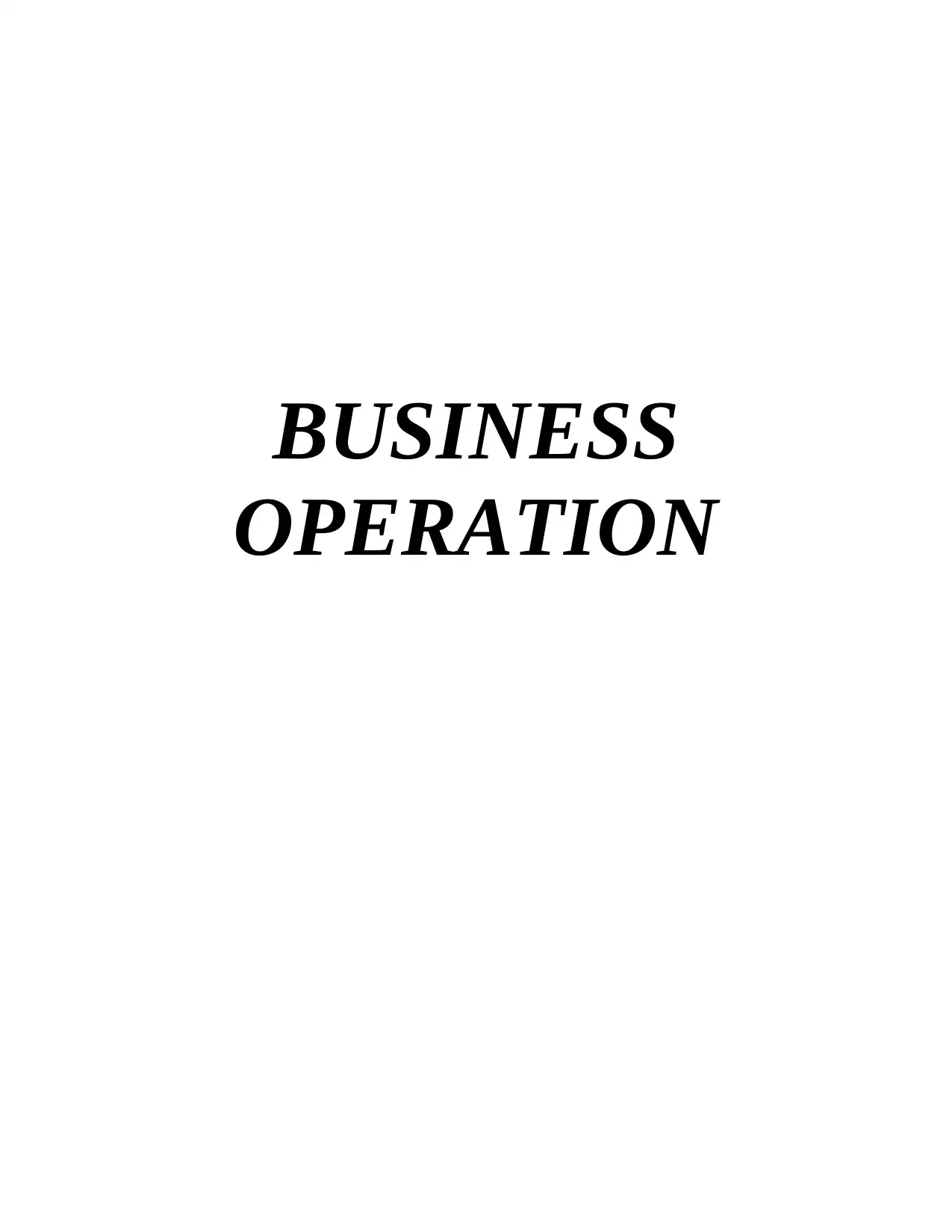
BUSINESS
OPERATION
OPERATION
Paraphrase This Document
Need a fresh take? Get an instant paraphrase of this document with our AI Paraphraser
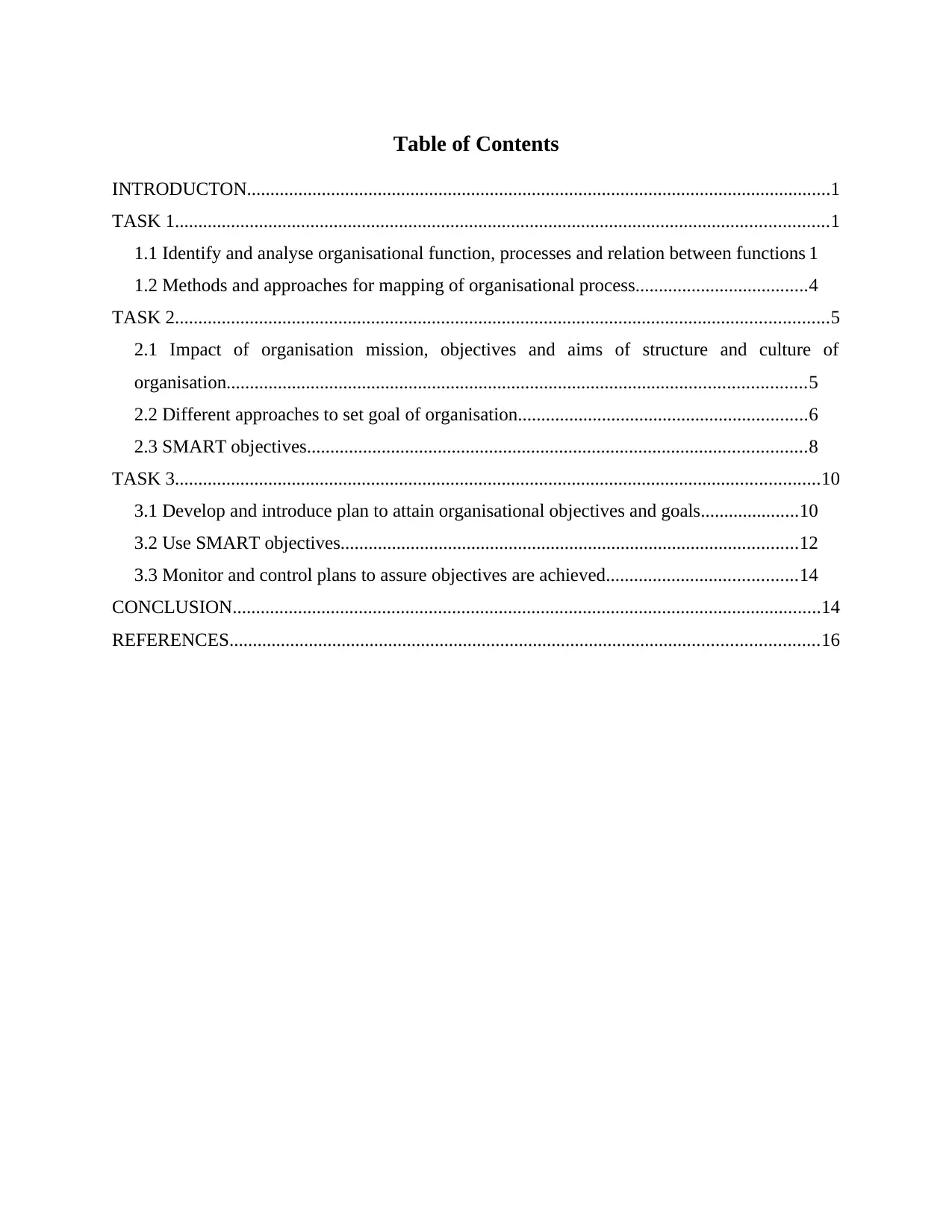
Table of Contents
INTRODUCTON.............................................................................................................................1
TASK 1............................................................................................................................................1
1.1 Identify and analyse organisational function, processes and relation between functions 1
1.2 Methods and approaches for mapping of organisational process.....................................4
TASK 2............................................................................................................................................5
2.1 Impact of organisation mission, objectives and aims of structure and culture of
organisation............................................................................................................................5
2.2 Different approaches to set goal of organisation..............................................................6
2.3 SMART objectives...........................................................................................................8
TASK 3..........................................................................................................................................10
3.1 Develop and introduce plan to attain organisational objectives and goals.....................10
3.2 Use SMART objectives..................................................................................................12
3.3 Monitor and control plans to assure objectives are achieved.........................................14
CONCLUSION..............................................................................................................................14
REFERENCES..............................................................................................................................16
INTRODUCTON.............................................................................................................................1
TASK 1............................................................................................................................................1
1.1 Identify and analyse organisational function, processes and relation between functions 1
1.2 Methods and approaches for mapping of organisational process.....................................4
TASK 2............................................................................................................................................5
2.1 Impact of organisation mission, objectives and aims of structure and culture of
organisation............................................................................................................................5
2.2 Different approaches to set goal of organisation..............................................................6
2.3 SMART objectives...........................................................................................................8
TASK 3..........................................................................................................................................10
3.1 Develop and introduce plan to attain organisational objectives and goals.....................10
3.2 Use SMART objectives..................................................................................................12
3.3 Monitor and control plans to assure objectives are achieved.........................................14
CONCLUSION..............................................................................................................................14
REFERENCES..............................................................................................................................16

You're viewing a preview
Unlock full access by subscribing today!
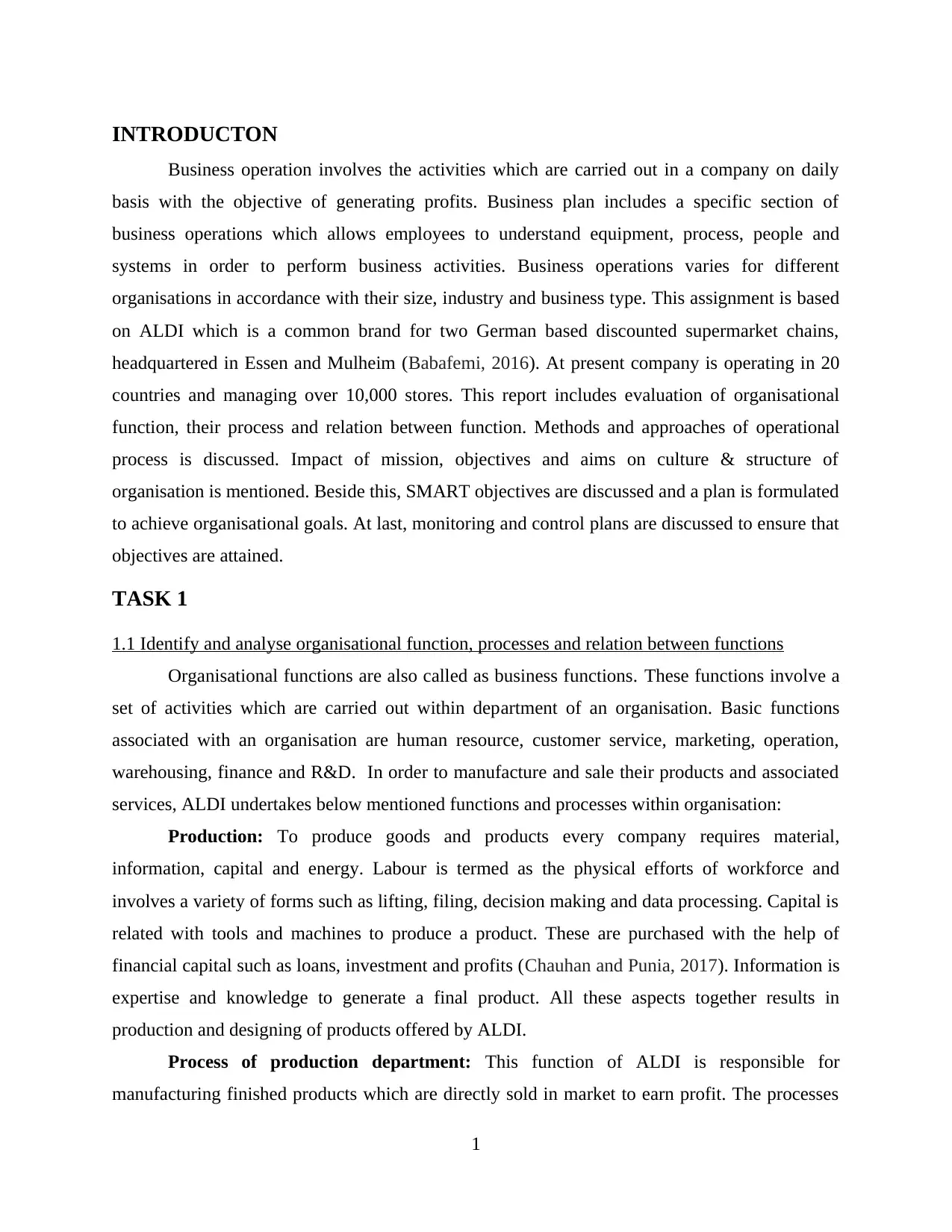
INTRODUCTON
Business operation involves the activities which are carried out in a company on daily
basis with the objective of generating profits. Business plan includes a specific section of
business operations which allows employees to understand equipment, process, people and
systems in order to perform business activities. Business operations varies for different
organisations in accordance with their size, industry and business type. This assignment is based
on ALDI which is a common brand for two German based discounted supermarket chains,
headquartered in Essen and Mulheim (Babafemi, 2016). At present company is operating in 20
countries and managing over 10,000 stores. This report includes evaluation of organisational
function, their process and relation between function. Methods and approaches of operational
process is discussed. Impact of mission, objectives and aims on culture & structure of
organisation is mentioned. Beside this, SMART objectives are discussed and a plan is formulated
to achieve organisational goals. At last, monitoring and control plans are discussed to ensure that
objectives are attained.
TASK 1
1.1 Identify and analyse organisational function, processes and relation between functions
Organisational functions are also called as business functions. These functions involve a
set of activities which are carried out within department of an organisation. Basic functions
associated with an organisation are human resource, customer service, marketing, operation,
warehousing, finance and R&D. In order to manufacture and sale their products and associated
services, ALDI undertakes below mentioned functions and processes within organisation:
Production: To produce goods and products every company requires material,
information, capital and energy. Labour is termed as the physical efforts of workforce and
involves a variety of forms such as lifting, filing, decision making and data processing. Capital is
related with tools and machines to produce a product. These are purchased with the help of
financial capital such as loans, investment and profits (Chauhan and Punia, 2017). Information is
expertise and knowledge to generate a final product. All these aspects together results in
production and designing of products offered by ALDI.
Process of production department: This function of ALDI is responsible for
manufacturing finished products which are directly sold in market to earn profit. The processes
1
Business operation involves the activities which are carried out in a company on daily
basis with the objective of generating profits. Business plan includes a specific section of
business operations which allows employees to understand equipment, process, people and
systems in order to perform business activities. Business operations varies for different
organisations in accordance with their size, industry and business type. This assignment is based
on ALDI which is a common brand for two German based discounted supermarket chains,
headquartered in Essen and Mulheim (Babafemi, 2016). At present company is operating in 20
countries and managing over 10,000 stores. This report includes evaluation of organisational
function, their process and relation between function. Methods and approaches of operational
process is discussed. Impact of mission, objectives and aims on culture & structure of
organisation is mentioned. Beside this, SMART objectives are discussed and a plan is formulated
to achieve organisational goals. At last, monitoring and control plans are discussed to ensure that
objectives are attained.
TASK 1
1.1 Identify and analyse organisational function, processes and relation between functions
Organisational functions are also called as business functions. These functions involve a
set of activities which are carried out within department of an organisation. Basic functions
associated with an organisation are human resource, customer service, marketing, operation,
warehousing, finance and R&D. In order to manufacture and sale their products and associated
services, ALDI undertakes below mentioned functions and processes within organisation:
Production: To produce goods and products every company requires material,
information, capital and energy. Labour is termed as the physical efforts of workforce and
involves a variety of forms such as lifting, filing, decision making and data processing. Capital is
related with tools and machines to produce a product. These are purchased with the help of
financial capital such as loans, investment and profits (Chauhan and Punia, 2017). Information is
expertise and knowledge to generate a final product. All these aspects together results in
production and designing of products offered by ALDI.
Process of production department: This function of ALDI is responsible for
manufacturing finished products which are directly sold in market to earn profit. The processes
1
Paraphrase This Document
Need a fresh take? Get an instant paraphrase of this document with our AI Paraphraser
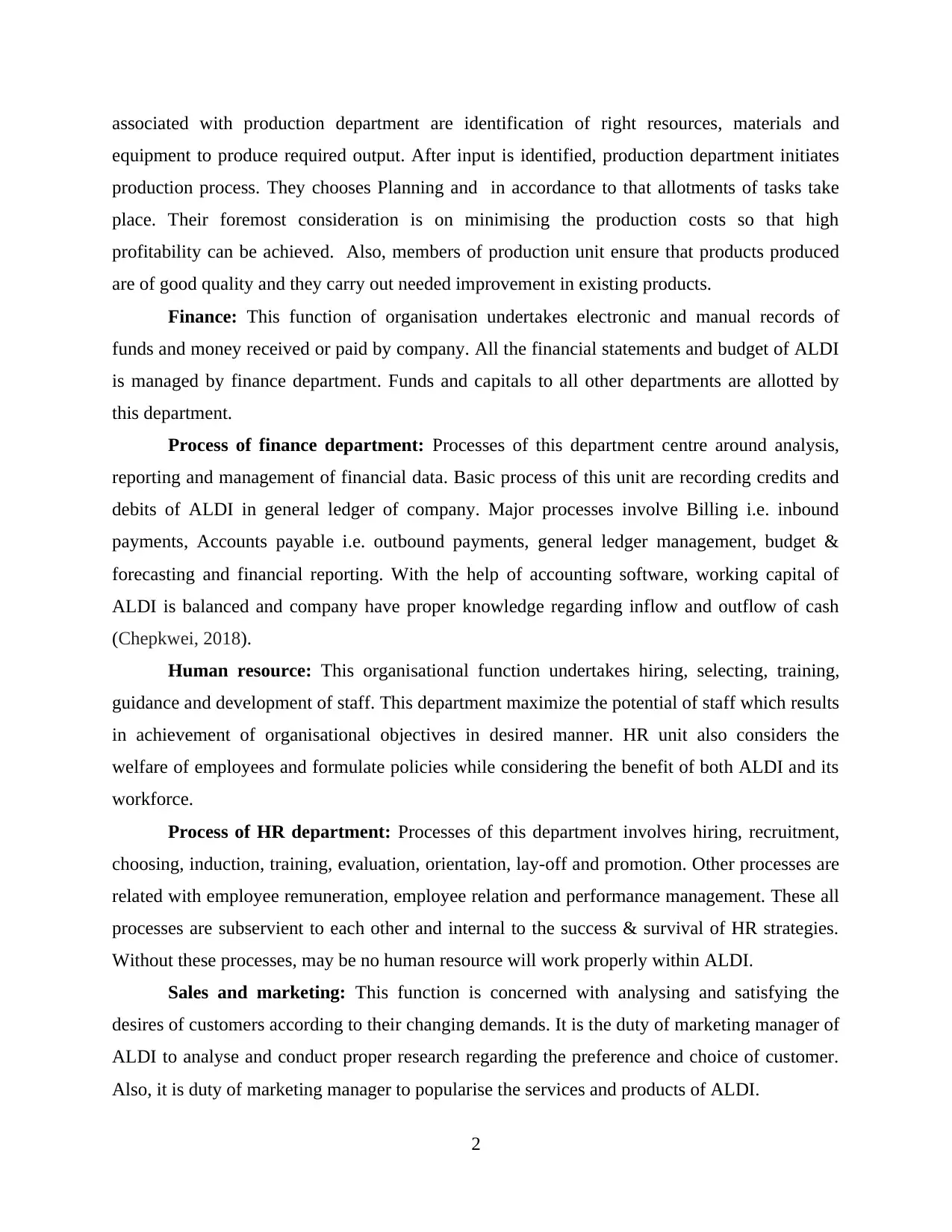
associated with production department are identification of right resources, materials and
equipment to produce required output. After input is identified, production department initiates
production process. They chooses Planning and in accordance to that allotments of tasks take
place. Their foremost consideration is on minimising the production costs so that high
profitability can be achieved. Also, members of production unit ensure that products produced
are of good quality and they carry out needed improvement in existing products.
Finance: This function of organisation undertakes electronic and manual records of
funds and money received or paid by company. All the financial statements and budget of ALDI
is managed by finance department. Funds and capitals to all other departments are allotted by
this department.
Process of finance department: Processes of this department centre around analysis,
reporting and management of financial data. Basic process of this unit are recording credits and
debits of ALDI in general ledger of company. Major processes involve Billing i.e. inbound
payments, Accounts payable i.e. outbound payments, general ledger management, budget &
forecasting and financial reporting. With the help of accounting software, working capital of
ALDI is balanced and company have proper knowledge regarding inflow and outflow of cash
(Chepkwei, 2018).
Human resource: This organisational function undertakes hiring, selecting, training,
guidance and development of staff. This department maximize the potential of staff which results
in achievement of organisational objectives in desired manner. HR unit also considers the
welfare of employees and formulate policies while considering the benefit of both ALDI and its
workforce.
Process of HR department: Processes of this department involves hiring, recruitment,
choosing, induction, training, evaluation, orientation, lay-off and promotion. Other processes are
related with employee remuneration, employee relation and performance management. These all
processes are subservient to each other and internal to the success & survival of HR strategies.
Without these processes, may be no human resource will work properly within ALDI.
Sales and marketing: This function is concerned with analysing and satisfying the
desires of customers according to their changing demands. It is the duty of marketing manager of
ALDI to analyse and conduct proper research regarding the preference and choice of customer.
Also, it is duty of marketing manager to popularise the services and products of ALDI.
2
equipment to produce required output. After input is identified, production department initiates
production process. They chooses Planning and in accordance to that allotments of tasks take
place. Their foremost consideration is on minimising the production costs so that high
profitability can be achieved. Also, members of production unit ensure that products produced
are of good quality and they carry out needed improvement in existing products.
Finance: This function of organisation undertakes electronic and manual records of
funds and money received or paid by company. All the financial statements and budget of ALDI
is managed by finance department. Funds and capitals to all other departments are allotted by
this department.
Process of finance department: Processes of this department centre around analysis,
reporting and management of financial data. Basic process of this unit are recording credits and
debits of ALDI in general ledger of company. Major processes involve Billing i.e. inbound
payments, Accounts payable i.e. outbound payments, general ledger management, budget &
forecasting and financial reporting. With the help of accounting software, working capital of
ALDI is balanced and company have proper knowledge regarding inflow and outflow of cash
(Chepkwei, 2018).
Human resource: This organisational function undertakes hiring, selecting, training,
guidance and development of staff. This department maximize the potential of staff which results
in achievement of organisational objectives in desired manner. HR unit also considers the
welfare of employees and formulate policies while considering the benefit of both ALDI and its
workforce.
Process of HR department: Processes of this department involves hiring, recruitment,
choosing, induction, training, evaluation, orientation, lay-off and promotion. Other processes are
related with employee remuneration, employee relation and performance management. These all
processes are subservient to each other and internal to the success & survival of HR strategies.
Without these processes, may be no human resource will work properly within ALDI.
Sales and marketing: This function is concerned with analysing and satisfying the
desires of customers according to their changing demands. It is the duty of marketing manager of
ALDI to analyse and conduct proper research regarding the preference and choice of customer.
Also, it is duty of marketing manager to popularise the services and products of ALDI.
2
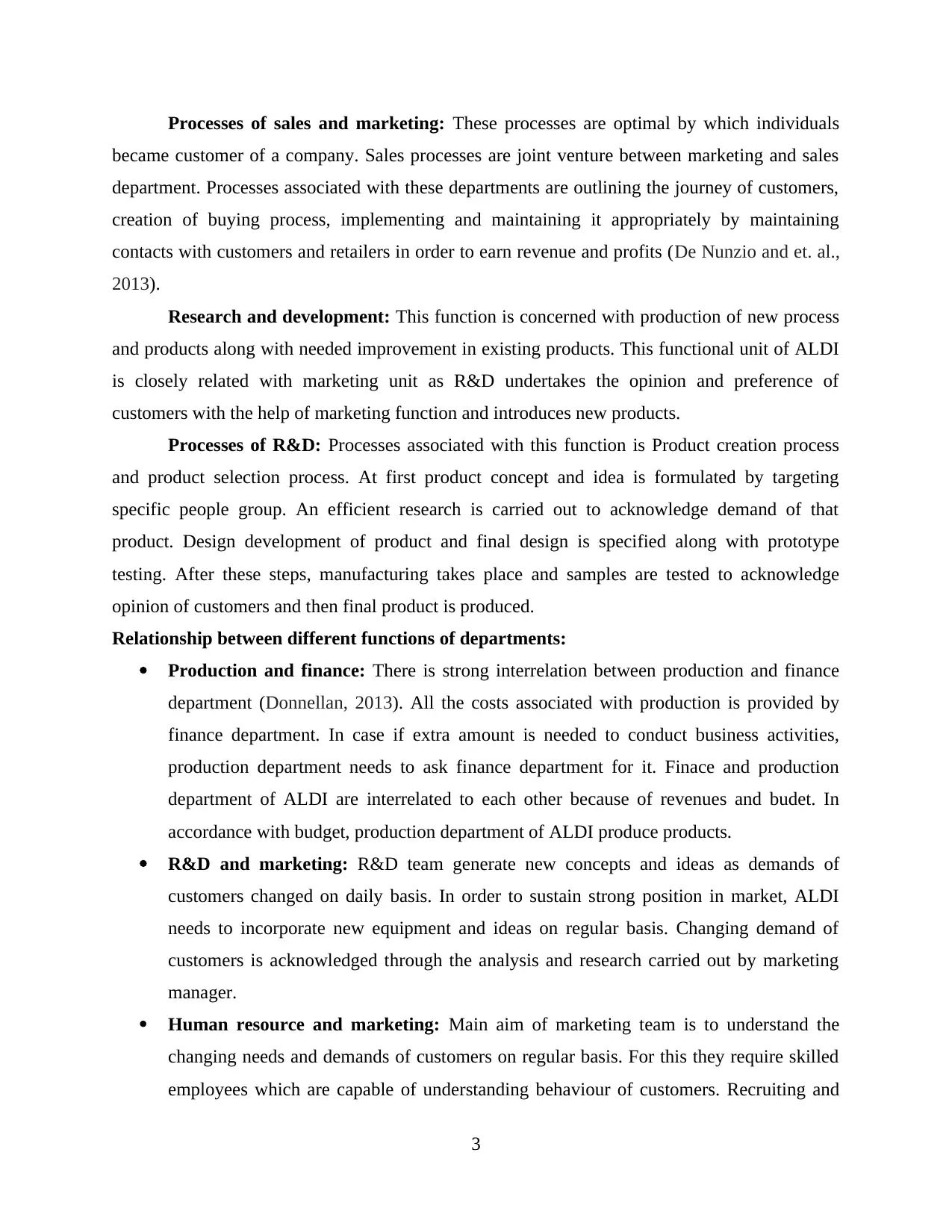
Processes of sales and marketing: These processes are optimal by which individuals
became customer of a company. Sales processes are joint venture between marketing and sales
department. Processes associated with these departments are outlining the journey of customers,
creation of buying process, implementing and maintaining it appropriately by maintaining
contacts with customers and retailers in order to earn revenue and profits (De Nunzio and et. al.,
2013).
Research and development: This function is concerned with production of new process
and products along with needed improvement in existing products. This functional unit of ALDI
is closely related with marketing unit as R&D undertakes the opinion and preference of
customers with the help of marketing function and introduces new products.
Processes of R&D: Processes associated with this function is Product creation process
and product selection process. At first product concept and idea is formulated by targeting
specific people group. An efficient research is carried out to acknowledge demand of that
product. Design development of product and final design is specified along with prototype
testing. After these steps, manufacturing takes place and samples are tested to acknowledge
opinion of customers and then final product is produced.
Relationship between different functions of departments:
Production and finance: There is strong interrelation between production and finance
department (Donnellan, 2013). All the costs associated with production is provided by
finance department. In case if extra amount is needed to conduct business activities,
production department needs to ask finance department for it. Finace and production
department of ALDI are interrelated to each other because of revenues and budet. In
accordance with budget, production department of ALDI produce products.
R&D and marketing: R&D team generate new concepts and ideas as demands of
customers changed on daily basis. In order to sustain strong position in market, ALDI
needs to incorporate new equipment and ideas on regular basis. Changing demand of
customers is acknowledged through the analysis and research carried out by marketing
manager.
Human resource and marketing: Main aim of marketing team is to understand the
changing needs and demands of customers on regular basis. For this they require skilled
employees which are capable of understanding behaviour of customers. Recruiting and
3
became customer of a company. Sales processes are joint venture between marketing and sales
department. Processes associated with these departments are outlining the journey of customers,
creation of buying process, implementing and maintaining it appropriately by maintaining
contacts with customers and retailers in order to earn revenue and profits (De Nunzio and et. al.,
2013).
Research and development: This function is concerned with production of new process
and products along with needed improvement in existing products. This functional unit of ALDI
is closely related with marketing unit as R&D undertakes the opinion and preference of
customers with the help of marketing function and introduces new products.
Processes of R&D: Processes associated with this function is Product creation process
and product selection process. At first product concept and idea is formulated by targeting
specific people group. An efficient research is carried out to acknowledge demand of that
product. Design development of product and final design is specified along with prototype
testing. After these steps, manufacturing takes place and samples are tested to acknowledge
opinion of customers and then final product is produced.
Relationship between different functions of departments:
Production and finance: There is strong interrelation between production and finance
department (Donnellan, 2013). All the costs associated with production is provided by
finance department. In case if extra amount is needed to conduct business activities,
production department needs to ask finance department for it. Finace and production
department of ALDI are interrelated to each other because of revenues and budet. In
accordance with budget, production department of ALDI produce products.
R&D and marketing: R&D team generate new concepts and ideas as demands of
customers changed on daily basis. In order to sustain strong position in market, ALDI
needs to incorporate new equipment and ideas on regular basis. Changing demand of
customers is acknowledged through the analysis and research carried out by marketing
manager.
Human resource and marketing: Main aim of marketing team is to understand the
changing needs and demands of customers on regular basis. For this they require skilled
employees which are capable of understanding behaviour of customers. Recruiting and
3
You're viewing a preview
Unlock full access by subscribing today!
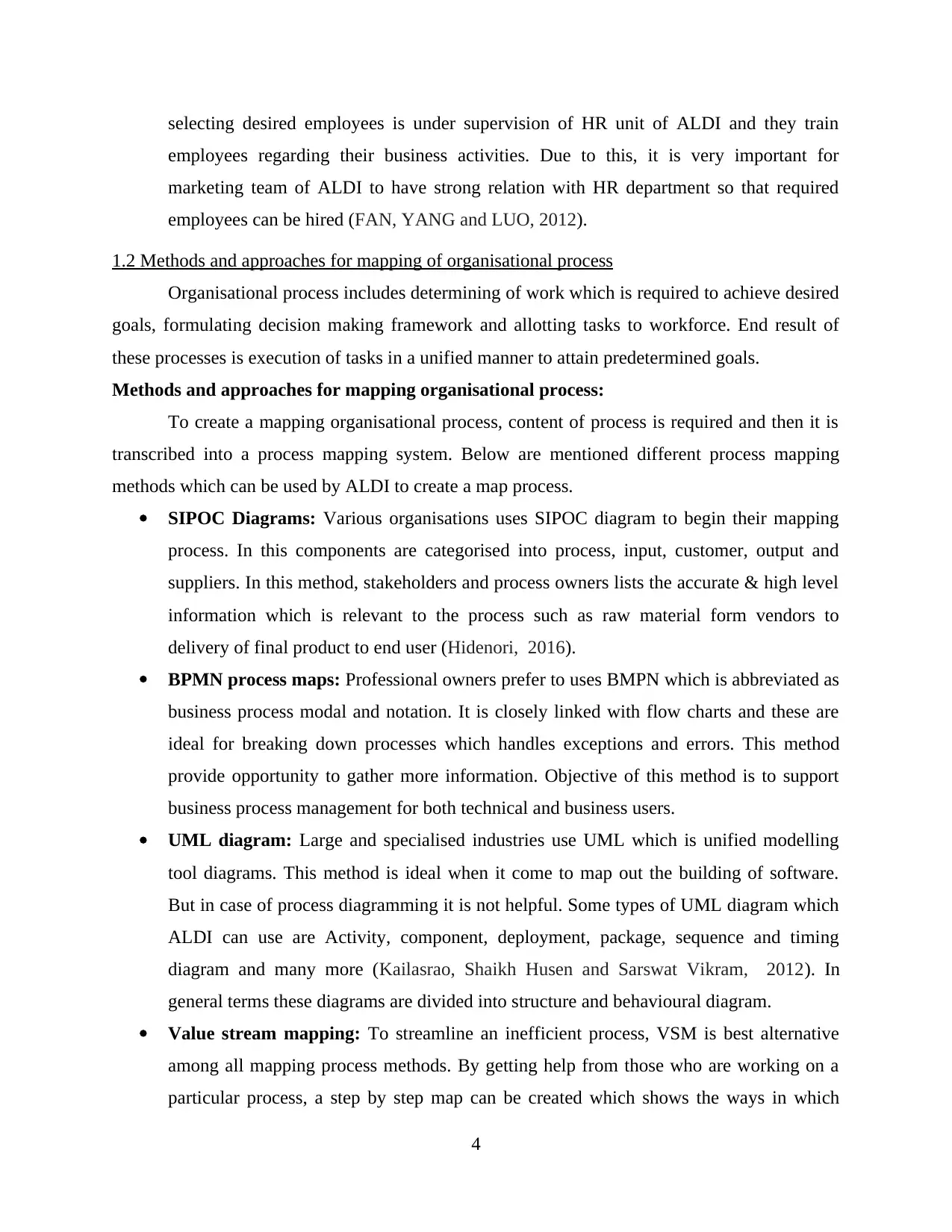
selecting desired employees is under supervision of HR unit of ALDI and they train
employees regarding their business activities. Due to this, it is very important for
marketing team of ALDI to have strong relation with HR department so that required
employees can be hired (FAN, YANG and LUO, 2012).
1.2 Methods and approaches for mapping of organisational process
Organisational process includes determining of work which is required to achieve desired
goals, formulating decision making framework and allotting tasks to workforce. End result of
these processes is execution of tasks in a unified manner to attain predetermined goals.
Methods and approaches for mapping organisational process:
To create a mapping organisational process, content of process is required and then it is
transcribed into a process mapping system. Below are mentioned different process mapping
methods which can be used by ALDI to create a map process.
SIPOC Diagrams: Various organisations uses SIPOC diagram to begin their mapping
process. In this components are categorised into process, input, customer, output and
suppliers. In this method, stakeholders and process owners lists the accurate & high level
information which is relevant to the process such as raw material form vendors to
delivery of final product to end user (Hidenori, 2016).
BPMN process maps: Professional owners prefer to uses BMPN which is abbreviated as
business process modal and notation. It is closely linked with flow charts and these are
ideal for breaking down processes which handles exceptions and errors. This method
provide opportunity to gather more information. Objective of this method is to support
business process management for both technical and business users.
UML diagram: Large and specialised industries use UML which is unified modelling
tool diagrams. This method is ideal when it come to map out the building of software.
But in case of process diagramming it is not helpful. Some types of UML diagram which
ALDI can use are Activity, component, deployment, package, sequence and timing
diagram and many more (Kailasrao, Shaikh Husen and Sarswat Vikram, 2012). In
general terms these diagrams are divided into structure and behavioural diagram.
Value stream mapping: To streamline an inefficient process, VSM is best alternative
among all mapping process methods. By getting help from those who are working on a
particular process, a step by step map can be created which shows the ways in which
4
employees regarding their business activities. Due to this, it is very important for
marketing team of ALDI to have strong relation with HR department so that required
employees can be hired (FAN, YANG and LUO, 2012).
1.2 Methods and approaches for mapping of organisational process
Organisational process includes determining of work which is required to achieve desired
goals, formulating decision making framework and allotting tasks to workforce. End result of
these processes is execution of tasks in a unified manner to attain predetermined goals.
Methods and approaches for mapping organisational process:
To create a mapping organisational process, content of process is required and then it is
transcribed into a process mapping system. Below are mentioned different process mapping
methods which can be used by ALDI to create a map process.
SIPOC Diagrams: Various organisations uses SIPOC diagram to begin their mapping
process. In this components are categorised into process, input, customer, output and
suppliers. In this method, stakeholders and process owners lists the accurate & high level
information which is relevant to the process such as raw material form vendors to
delivery of final product to end user (Hidenori, 2016).
BPMN process maps: Professional owners prefer to uses BMPN which is abbreviated as
business process modal and notation. It is closely linked with flow charts and these are
ideal for breaking down processes which handles exceptions and errors. This method
provide opportunity to gather more information. Objective of this method is to support
business process management for both technical and business users.
UML diagram: Large and specialised industries use UML which is unified modelling
tool diagrams. This method is ideal when it come to map out the building of software.
But in case of process diagramming it is not helpful. Some types of UML diagram which
ALDI can use are Activity, component, deployment, package, sequence and timing
diagram and many more (Kailasrao, Shaikh Husen and Sarswat Vikram, 2012). In
general terms these diagrams are divided into structure and behavioural diagram.
Value stream mapping: To streamline an inefficient process, VSM is best alternative
among all mapping process methods. By getting help from those who are working on a
particular process, a step by step map can be created which shows the ways in which
4
Paraphrase This Document
Need a fresh take? Get an instant paraphrase of this document with our AI Paraphraser
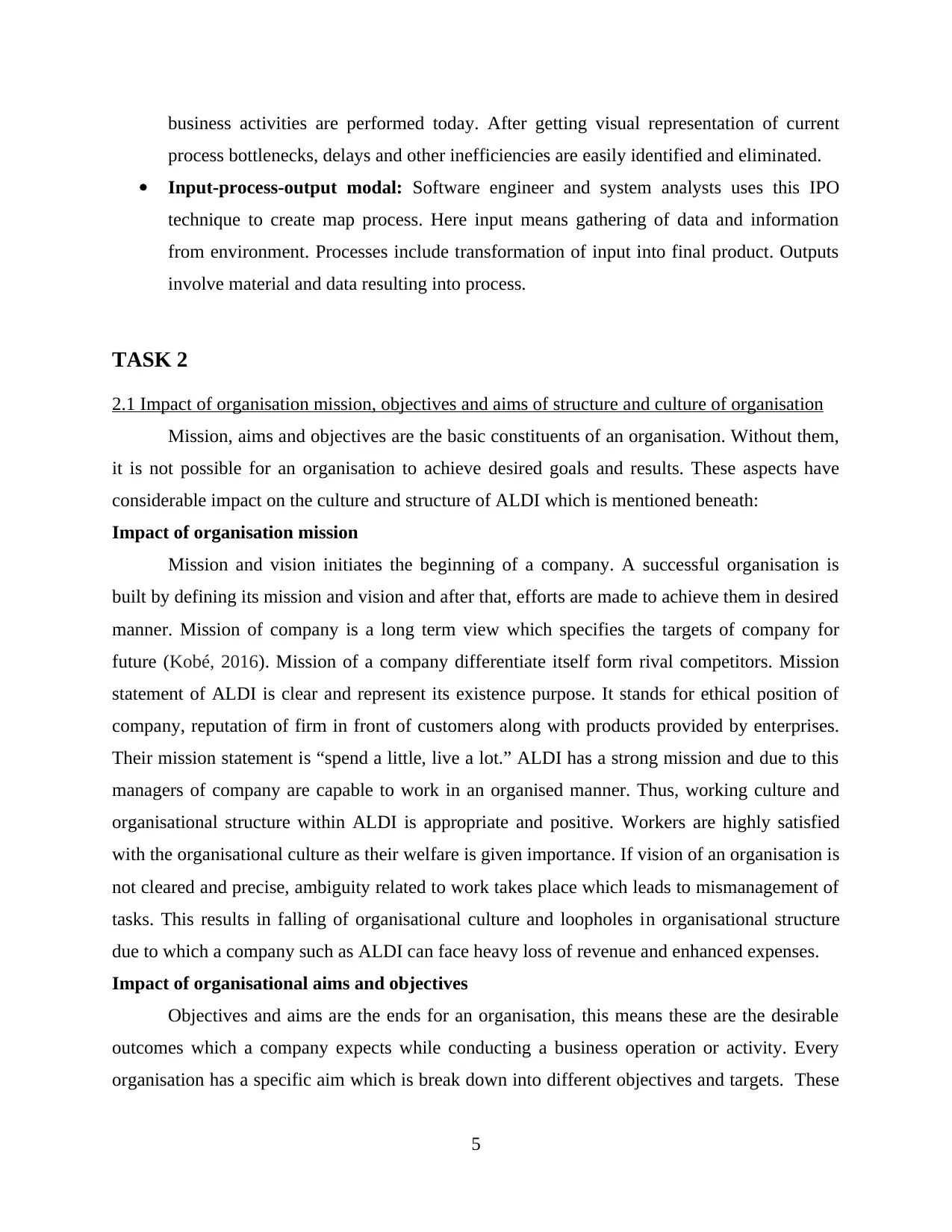
business activities are performed today. After getting visual representation of current
process bottlenecks, delays and other inefficiencies are easily identified and eliminated.
Input-process-output modal: Software engineer and system analysts uses this IPO
technique to create map process. Here input means gathering of data and information
from environment. Processes include transformation of input into final product. Outputs
involve material and data resulting into process.
TASK 2
2.1 Impact of organisation mission, objectives and aims of structure and culture of organisation
Mission, aims and objectives are the basic constituents of an organisation. Without them,
it is not possible for an organisation to achieve desired goals and results. These aspects have
considerable impact on the culture and structure of ALDI which is mentioned beneath:
Impact of organisation mission
Mission and vision initiates the beginning of a company. A successful organisation is
built by defining its mission and vision and after that, efforts are made to achieve them in desired
manner. Mission of company is a long term view which specifies the targets of company for
future (Kobé, 2016). Mission of a company differentiate itself form rival competitors. Mission
statement of ALDI is clear and represent its existence purpose. It stands for ethical position of
company, reputation of firm in front of customers along with products provided by enterprises.
Their mission statement is “spend a little, live a lot.” ALDI has a strong mission and due to this
managers of company are capable to work in an organised manner. Thus, working culture and
organisational structure within ALDI is appropriate and positive. Workers are highly satisfied
with the organisational culture as their welfare is given importance. If vision of an organisation is
not cleared and precise, ambiguity related to work takes place which leads to mismanagement of
tasks. This results in falling of organisational culture and loopholes in organisational structure
due to which a company such as ALDI can face heavy loss of revenue and enhanced expenses.
Impact of organisational aims and objectives
Objectives and aims are the ends for an organisation, this means these are the desirable
outcomes which a company expects while conducting a business operation or activity. Every
organisation has a specific aim which is break down into different objectives and targets. These
5
process bottlenecks, delays and other inefficiencies are easily identified and eliminated.
Input-process-output modal: Software engineer and system analysts uses this IPO
technique to create map process. Here input means gathering of data and information
from environment. Processes include transformation of input into final product. Outputs
involve material and data resulting into process.
TASK 2
2.1 Impact of organisation mission, objectives and aims of structure and culture of organisation
Mission, aims and objectives are the basic constituents of an organisation. Without them,
it is not possible for an organisation to achieve desired goals and results. These aspects have
considerable impact on the culture and structure of ALDI which is mentioned beneath:
Impact of organisation mission
Mission and vision initiates the beginning of a company. A successful organisation is
built by defining its mission and vision and after that, efforts are made to achieve them in desired
manner. Mission of company is a long term view which specifies the targets of company for
future (Kobé, 2016). Mission of a company differentiate itself form rival competitors. Mission
statement of ALDI is clear and represent its existence purpose. It stands for ethical position of
company, reputation of firm in front of customers along with products provided by enterprises.
Their mission statement is “spend a little, live a lot.” ALDI has a strong mission and due to this
managers of company are capable to work in an organised manner. Thus, working culture and
organisational structure within ALDI is appropriate and positive. Workers are highly satisfied
with the organisational culture as their welfare is given importance. If vision of an organisation is
not cleared and precise, ambiguity related to work takes place which leads to mismanagement of
tasks. This results in falling of organisational culture and loopholes in organisational structure
due to which a company such as ALDI can face heavy loss of revenue and enhanced expenses.
Impact of organisational aims and objectives
Objectives and aims are the ends for an organisation, this means these are the desirable
outcomes which a company expects while conducting a business operation or activity. Every
organisation has a specific aim which is break down into different objectives and targets. These
5
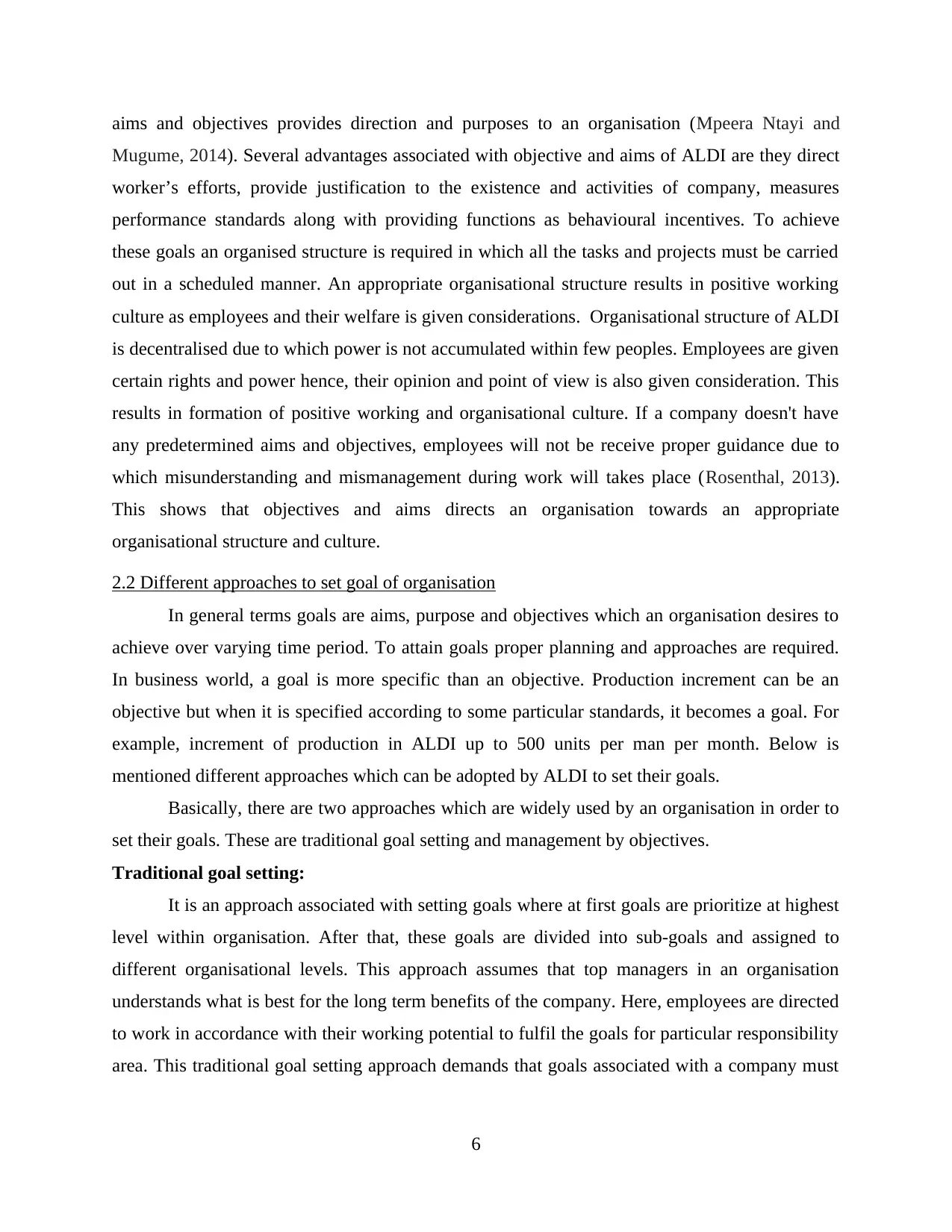
aims and objectives provides direction and purposes to an organisation (Mpeera Ntayi and
Mugume, 2014). Several advantages associated with objective and aims of ALDI are they direct
worker’s efforts, provide justification to the existence and activities of company, measures
performance standards along with providing functions as behavioural incentives. To achieve
these goals an organised structure is required in which all the tasks and projects must be carried
out in a scheduled manner. An appropriate organisational structure results in positive working
culture as employees and their welfare is given considerations. Organisational structure of ALDI
is decentralised due to which power is not accumulated within few peoples. Employees are given
certain rights and power hence, their opinion and point of view is also given consideration. This
results in formation of positive working and organisational culture. If a company doesn't have
any predetermined aims and objectives, employees will not be receive proper guidance due to
which misunderstanding and mismanagement during work will takes place (Rosenthal, 2013).
This shows that objectives and aims directs an organisation towards an appropriate
organisational structure and culture.
2.2 Different approaches to set goal of organisation
In general terms goals are aims, purpose and objectives which an organisation desires to
achieve over varying time period. To attain goals proper planning and approaches are required.
In business world, a goal is more specific than an objective. Production increment can be an
objective but when it is specified according to some particular standards, it becomes a goal. For
example, increment of production in ALDI up to 500 units per man per month. Below is
mentioned different approaches which can be adopted by ALDI to set their goals.
Basically, there are two approaches which are widely used by an organisation in order to
set their goals. These are traditional goal setting and management by objectives.
Traditional goal setting:
It is an approach associated with setting goals where at first goals are prioritize at highest
level within organisation. After that, these goals are divided into sub-goals and assigned to
different organisational levels. This approach assumes that top managers in an organisation
understands what is best for the long term benefits of the company. Here, employees are directed
to work in accordance with their working potential to fulfil the goals for particular responsibility
area. This traditional goal setting approach demands that goals associated with a company must
6
Mugume, 2014). Several advantages associated with objective and aims of ALDI are they direct
worker’s efforts, provide justification to the existence and activities of company, measures
performance standards along with providing functions as behavioural incentives. To achieve
these goals an organised structure is required in which all the tasks and projects must be carried
out in a scheduled manner. An appropriate organisational structure results in positive working
culture as employees and their welfare is given considerations. Organisational structure of ALDI
is decentralised due to which power is not accumulated within few peoples. Employees are given
certain rights and power hence, their opinion and point of view is also given consideration. This
results in formation of positive working and organisational culture. If a company doesn't have
any predetermined aims and objectives, employees will not be receive proper guidance due to
which misunderstanding and mismanagement during work will takes place (Rosenthal, 2013).
This shows that objectives and aims directs an organisation towards an appropriate
organisational structure and culture.
2.2 Different approaches to set goal of organisation
In general terms goals are aims, purpose and objectives which an organisation desires to
achieve over varying time period. To attain goals proper planning and approaches are required.
In business world, a goal is more specific than an objective. Production increment can be an
objective but when it is specified according to some particular standards, it becomes a goal. For
example, increment of production in ALDI up to 500 units per man per month. Below is
mentioned different approaches which can be adopted by ALDI to set their goals.
Basically, there are two approaches which are widely used by an organisation in order to
set their goals. These are traditional goal setting and management by objectives.
Traditional goal setting:
It is an approach associated with setting goals where at first goals are prioritize at highest
level within organisation. After that, these goals are divided into sub-goals and assigned to
different organisational levels. This approach assumes that top managers in an organisation
understands what is best for the long term benefits of the company. Here, employees are directed
to work in accordance with their working potential to fulfil the goals for particular responsibility
area. This traditional goal setting approach demands that goals associated with a company must
6
You're viewing a preview
Unlock full access by subscribing today!
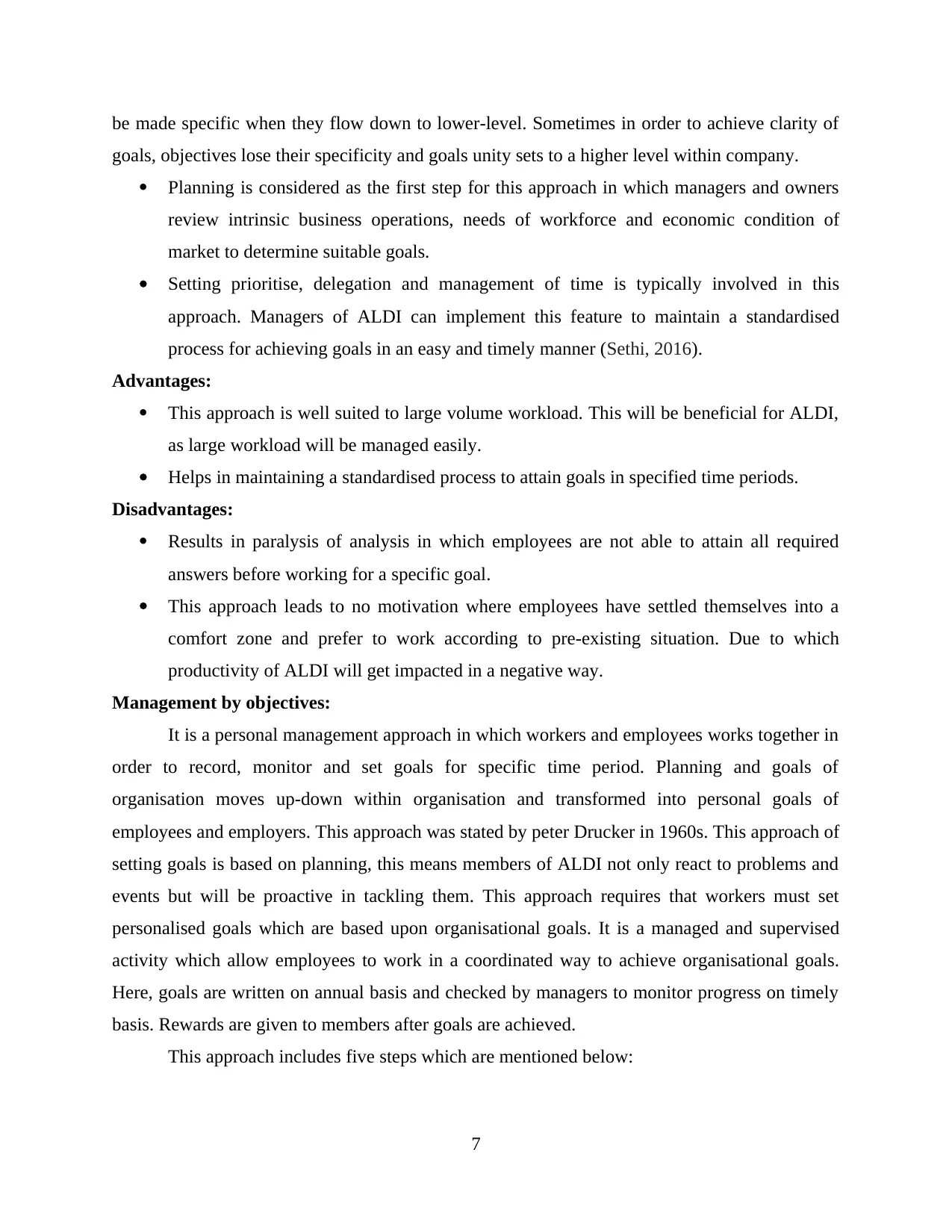
be made specific when they flow down to lower-level. Sometimes in order to achieve clarity of
goals, objectives lose their specificity and goals unity sets to a higher level within company.
Planning is considered as the first step for this approach in which managers and owners
review intrinsic business operations, needs of workforce and economic condition of
market to determine suitable goals.
Setting prioritise, delegation and management of time is typically involved in this
approach. Managers of ALDI can implement this feature to maintain a standardised
process for achieving goals in an easy and timely manner (Sethi, 2016).
Advantages:
This approach is well suited to large volume workload. This will be beneficial for ALDI,
as large workload will be managed easily.
Helps in maintaining a standardised process to attain goals in specified time periods.
Disadvantages:
Results in paralysis of analysis in which employees are not able to attain all required
answers before working for a specific goal.
This approach leads to no motivation where employees have settled themselves into a
comfort zone and prefer to work according to pre-existing situation. Due to which
productivity of ALDI will get impacted in a negative way.
Management by objectives:
It is a personal management approach in which workers and employees works together in
order to record, monitor and set goals for specific time period. Planning and goals of
organisation moves up-down within organisation and transformed into personal goals of
employees and employers. This approach was stated by peter Drucker in 1960s. This approach of
setting goals is based on planning, this means members of ALDI not only react to problems and
events but will be proactive in tackling them. This approach requires that workers must set
personalised goals which are based upon organisational goals. It is a managed and supervised
activity which allow employees to work in a coordinated way to achieve organisational goals.
Here, goals are written on annual basis and checked by managers to monitor progress on timely
basis. Rewards are given to members after goals are achieved.
This approach includes five steps which are mentioned below:
7
goals, objectives lose their specificity and goals unity sets to a higher level within company.
Planning is considered as the first step for this approach in which managers and owners
review intrinsic business operations, needs of workforce and economic condition of
market to determine suitable goals.
Setting prioritise, delegation and management of time is typically involved in this
approach. Managers of ALDI can implement this feature to maintain a standardised
process for achieving goals in an easy and timely manner (Sethi, 2016).
Advantages:
This approach is well suited to large volume workload. This will be beneficial for ALDI,
as large workload will be managed easily.
Helps in maintaining a standardised process to attain goals in specified time periods.
Disadvantages:
Results in paralysis of analysis in which employees are not able to attain all required
answers before working for a specific goal.
This approach leads to no motivation where employees have settled themselves into a
comfort zone and prefer to work according to pre-existing situation. Due to which
productivity of ALDI will get impacted in a negative way.
Management by objectives:
It is a personal management approach in which workers and employees works together in
order to record, monitor and set goals for specific time period. Planning and goals of
organisation moves up-down within organisation and transformed into personal goals of
employees and employers. This approach was stated by peter Drucker in 1960s. This approach of
setting goals is based on planning, this means members of ALDI not only react to problems and
events but will be proactive in tackling them. This approach requires that workers must set
personalised goals which are based upon organisational goals. It is a managed and supervised
activity which allow employees to work in a coordinated way to achieve organisational goals.
Here, goals are written on annual basis and checked by managers to monitor progress on timely
basis. Rewards are given to members after goals are achieved.
This approach includes five steps which are mentioned below:
7
Paraphrase This Document
Need a fresh take? Get an instant paraphrase of this document with our AI Paraphraser
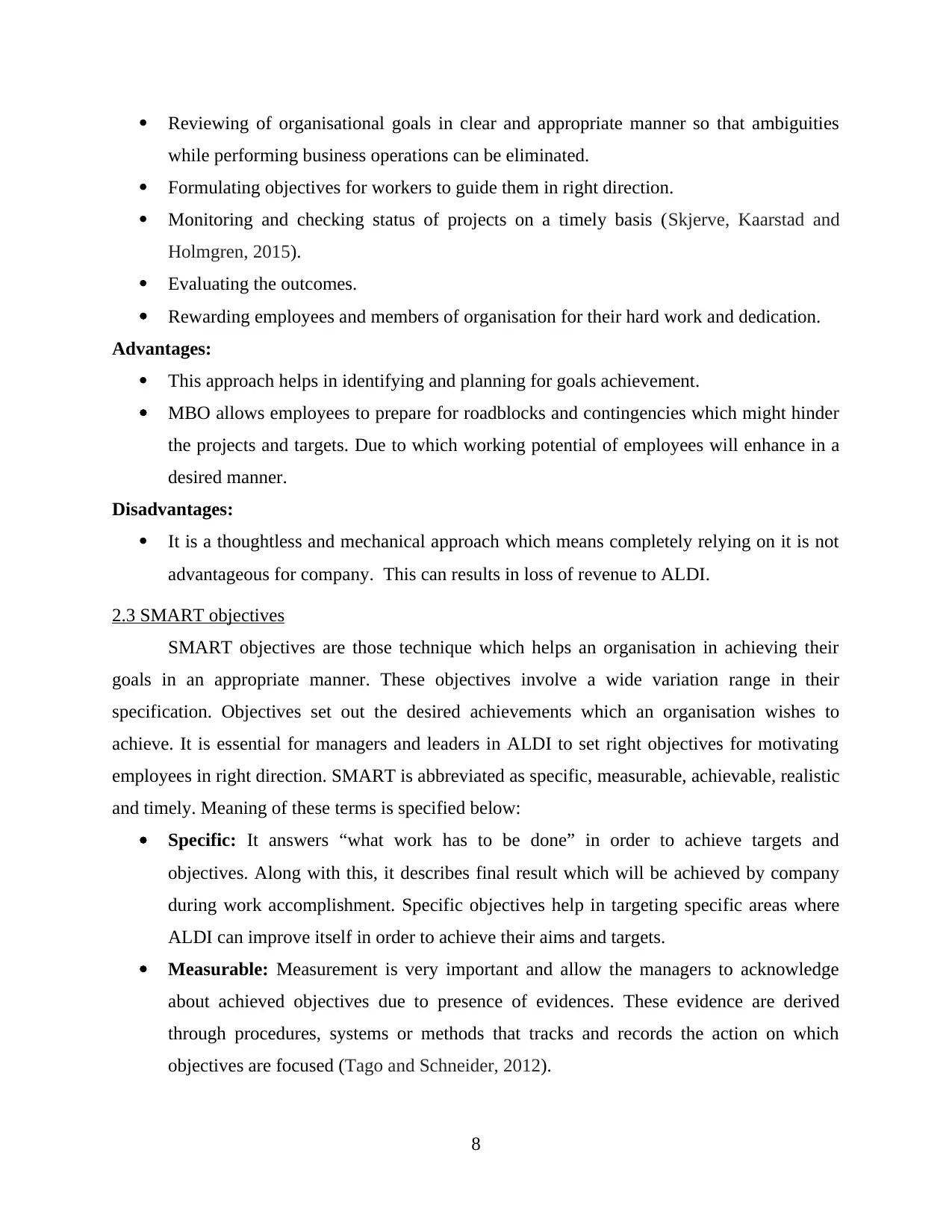
Reviewing of organisational goals in clear and appropriate manner so that ambiguities
while performing business operations can be eliminated.
Formulating objectives for workers to guide them in right direction.
Monitoring and checking status of projects on a timely basis (Skjerve, Kaarstad and
Holmgren, 2015).
Evaluating the outcomes.
Rewarding employees and members of organisation for their hard work and dedication.
Advantages:
This approach helps in identifying and planning for goals achievement.
MBO allows employees to prepare for roadblocks and contingencies which might hinder
the projects and targets. Due to which working potential of employees will enhance in a
desired manner.
Disadvantages:
It is a thoughtless and mechanical approach which means completely relying on it is not
advantageous for company. This can results in loss of revenue to ALDI.
2.3 SMART objectives
SMART objectives are those technique which helps an organisation in achieving their
goals in an appropriate manner. These objectives involve a wide variation range in their
specification. Objectives set out the desired achievements which an organisation wishes to
achieve. It is essential for managers and leaders in ALDI to set right objectives for motivating
employees in right direction. SMART is abbreviated as specific, measurable, achievable, realistic
and timely. Meaning of these terms is specified below:
Specific: It answers “what work has to be done” in order to achieve targets and
objectives. Along with this, it describes final result which will be achieved by company
during work accomplishment. Specific objectives help in targeting specific areas where
ALDI can improve itself in order to achieve their aims and targets.
Measurable: Measurement is very important and allow the managers to acknowledge
about achieved objectives due to presence of evidences. These evidence are derived
through procedures, systems or methods that tracks and records the action on which
objectives are focused (Tago and Schneider, 2012).
8
while performing business operations can be eliminated.
Formulating objectives for workers to guide them in right direction.
Monitoring and checking status of projects on a timely basis (Skjerve, Kaarstad and
Holmgren, 2015).
Evaluating the outcomes.
Rewarding employees and members of organisation for their hard work and dedication.
Advantages:
This approach helps in identifying and planning for goals achievement.
MBO allows employees to prepare for roadblocks and contingencies which might hinder
the projects and targets. Due to which working potential of employees will enhance in a
desired manner.
Disadvantages:
It is a thoughtless and mechanical approach which means completely relying on it is not
advantageous for company. This can results in loss of revenue to ALDI.
2.3 SMART objectives
SMART objectives are those technique which helps an organisation in achieving their
goals in an appropriate manner. These objectives involve a wide variation range in their
specification. Objectives set out the desired achievements which an organisation wishes to
achieve. It is essential for managers and leaders in ALDI to set right objectives for motivating
employees in right direction. SMART is abbreviated as specific, measurable, achievable, realistic
and timely. Meaning of these terms is specified below:
Specific: It answers “what work has to be done” in order to achieve targets and
objectives. Along with this, it describes final result which will be achieved by company
during work accomplishment. Specific objectives help in targeting specific areas where
ALDI can improve itself in order to achieve their aims and targets.
Measurable: Measurement is very important and allow the managers to acknowledge
about achieved objectives due to presence of evidences. These evidence are derived
through procedures, systems or methods that tracks and records the action on which
objectives are focused (Tago and Schneider, 2012).
8
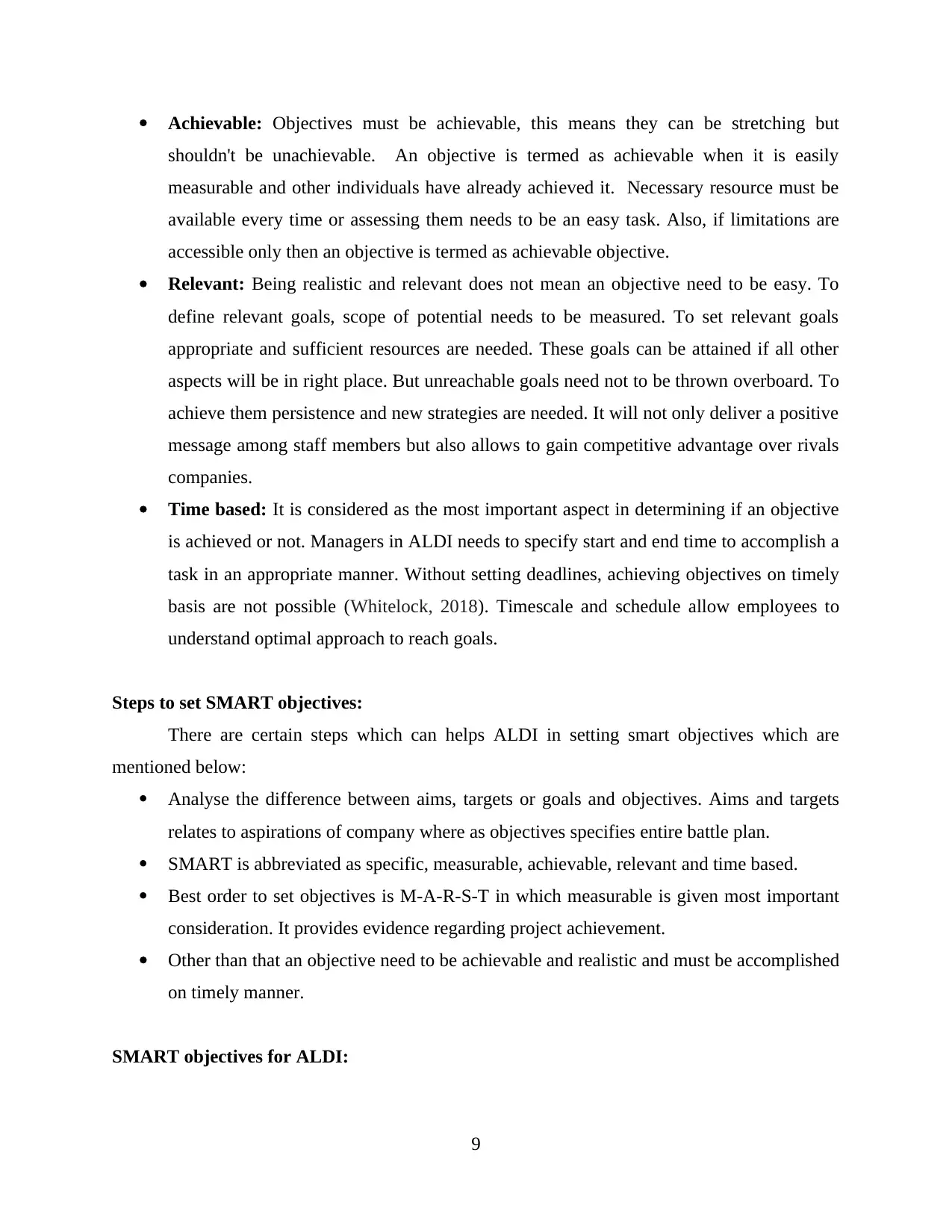
Achievable: Objectives must be achievable, this means they can be stretching but
shouldn't be unachievable. An objective is termed as achievable when it is easily
measurable and other individuals have already achieved it. Necessary resource must be
available every time or assessing them needs to be an easy task. Also, if limitations are
accessible only then an objective is termed as achievable objective.
Relevant: Being realistic and relevant does not mean an objective need to be easy. To
define relevant goals, scope of potential needs to be measured. To set relevant goals
appropriate and sufficient resources are needed. These goals can be attained if all other
aspects will be in right place. But unreachable goals need not to be thrown overboard. To
achieve them persistence and new strategies are needed. It will not only deliver a positive
message among staff members but also allows to gain competitive advantage over rivals
companies.
Time based: It is considered as the most important aspect in determining if an objective
is achieved or not. Managers in ALDI needs to specify start and end time to accomplish a
task in an appropriate manner. Without setting deadlines, achieving objectives on timely
basis are not possible (Whitelock, 2018). Timescale and schedule allow employees to
understand optimal approach to reach goals.
Steps to set SMART objectives:
There are certain steps which can helps ALDI in setting smart objectives which are
mentioned below:
Analyse the difference between aims, targets or goals and objectives. Aims and targets
relates to aspirations of company where as objectives specifies entire battle plan.
SMART is abbreviated as specific, measurable, achievable, relevant and time based.
Best order to set objectives is M-A-R-S-T in which measurable is given most important
consideration. It provides evidence regarding project achievement.
Other than that an objective need to be achievable and realistic and must be accomplished
on timely manner.
SMART objectives for ALDI:
9
shouldn't be unachievable. An objective is termed as achievable when it is easily
measurable and other individuals have already achieved it. Necessary resource must be
available every time or assessing them needs to be an easy task. Also, if limitations are
accessible only then an objective is termed as achievable objective.
Relevant: Being realistic and relevant does not mean an objective need to be easy. To
define relevant goals, scope of potential needs to be measured. To set relevant goals
appropriate and sufficient resources are needed. These goals can be attained if all other
aspects will be in right place. But unreachable goals need not to be thrown overboard. To
achieve them persistence and new strategies are needed. It will not only deliver a positive
message among staff members but also allows to gain competitive advantage over rivals
companies.
Time based: It is considered as the most important aspect in determining if an objective
is achieved or not. Managers in ALDI needs to specify start and end time to accomplish a
task in an appropriate manner. Without setting deadlines, achieving objectives on timely
basis are not possible (Whitelock, 2018). Timescale and schedule allow employees to
understand optimal approach to reach goals.
Steps to set SMART objectives:
There are certain steps which can helps ALDI in setting smart objectives which are
mentioned below:
Analyse the difference between aims, targets or goals and objectives. Aims and targets
relates to aspirations of company where as objectives specifies entire battle plan.
SMART is abbreviated as specific, measurable, achievable, relevant and time based.
Best order to set objectives is M-A-R-S-T in which measurable is given most important
consideration. It provides evidence regarding project achievement.
Other than that an objective need to be achievable and realistic and must be accomplished
on timely manner.
SMART objectives for ALDI:
9
You're viewing a preview
Unlock full access by subscribing today!
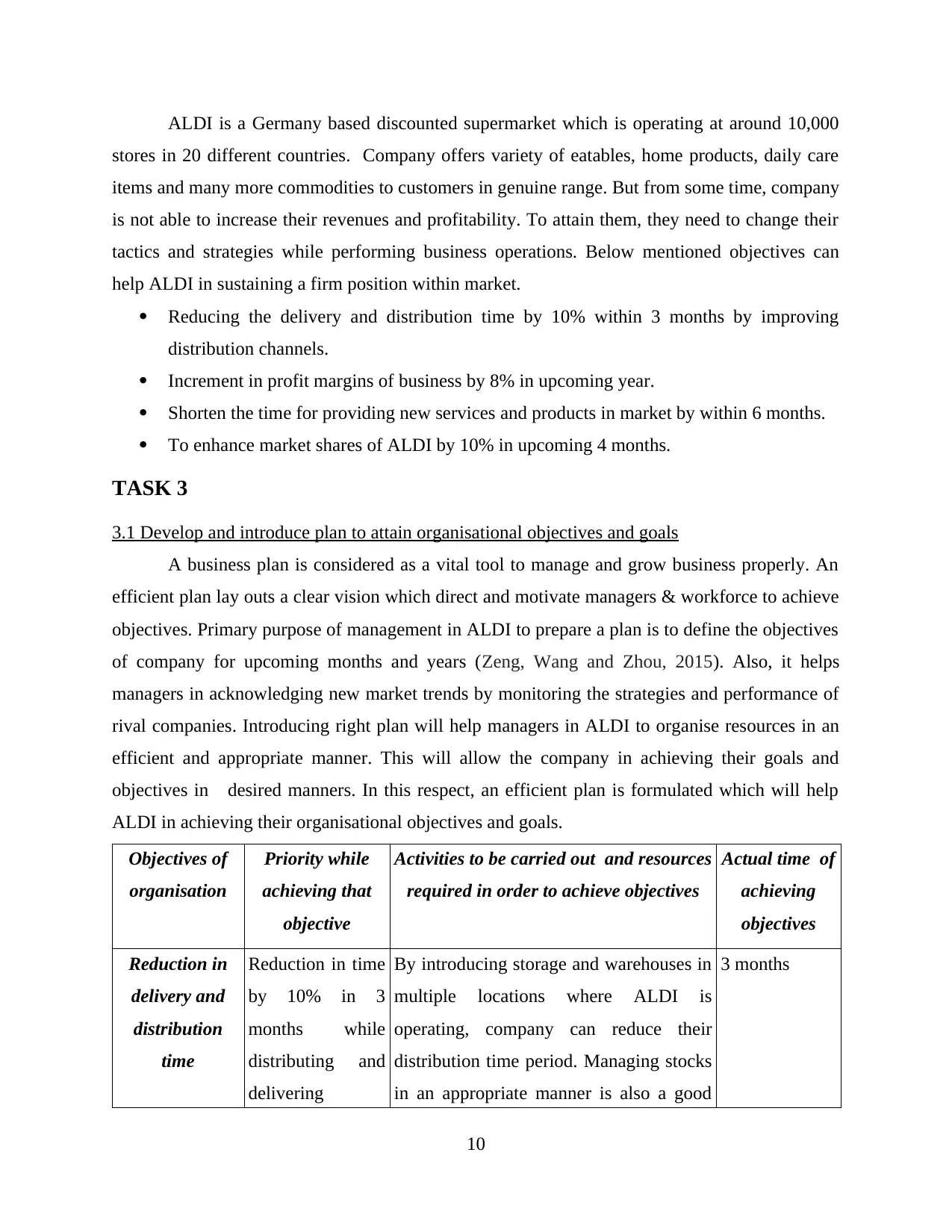
ALDI is a Germany based discounted supermarket which is operating at around 10,000
stores in 20 different countries. Company offers variety of eatables, home products, daily care
items and many more commodities to customers in genuine range. But from some time, company
is not able to increase their revenues and profitability. To attain them, they need to change their
tactics and strategies while performing business operations. Below mentioned objectives can
help ALDI in sustaining a firm position within market.
Reducing the delivery and distribution time by 10% within 3 months by improving
distribution channels.
Increment in profit margins of business by 8% in upcoming year.
Shorten the time for providing new services and products in market by within 6 months.
To enhance market shares of ALDI by 10% in upcoming 4 months.
TASK 3
3.1 Develop and introduce plan to attain organisational objectives and goals
A business plan is considered as a vital tool to manage and grow business properly. An
efficient plan lay outs a clear vision which direct and motivate managers & workforce to achieve
objectives. Primary purpose of management in ALDI to prepare a plan is to define the objectives
of company for upcoming months and years (Zeng, Wang and Zhou, 2015). Also, it helps
managers in acknowledging new market trends by monitoring the strategies and performance of
rival companies. Introducing right plan will help managers in ALDI to organise resources in an
efficient and appropriate manner. This will allow the company in achieving their goals and
objectives in desired manners. In this respect, an efficient plan is formulated which will help
ALDI in achieving their organisational objectives and goals.
Objectives of
organisation
Priority while
achieving that
objective
Activities to be carried out and resources
required in order to achieve objectives
Actual time of
achieving
objectives
Reduction in
delivery and
distribution
time
Reduction in time
by 10% in 3
months while
distributing and
delivering
By introducing storage and warehouses in
multiple locations where ALDI is
operating, company can reduce their
distribution time period. Managing stocks
in an appropriate manner is also a good
3 months
10
stores in 20 different countries. Company offers variety of eatables, home products, daily care
items and many more commodities to customers in genuine range. But from some time, company
is not able to increase their revenues and profitability. To attain them, they need to change their
tactics and strategies while performing business operations. Below mentioned objectives can
help ALDI in sustaining a firm position within market.
Reducing the delivery and distribution time by 10% within 3 months by improving
distribution channels.
Increment in profit margins of business by 8% in upcoming year.
Shorten the time for providing new services and products in market by within 6 months.
To enhance market shares of ALDI by 10% in upcoming 4 months.
TASK 3
3.1 Develop and introduce plan to attain organisational objectives and goals
A business plan is considered as a vital tool to manage and grow business properly. An
efficient plan lay outs a clear vision which direct and motivate managers & workforce to achieve
objectives. Primary purpose of management in ALDI to prepare a plan is to define the objectives
of company for upcoming months and years (Zeng, Wang and Zhou, 2015). Also, it helps
managers in acknowledging new market trends by monitoring the strategies and performance of
rival companies. Introducing right plan will help managers in ALDI to organise resources in an
efficient and appropriate manner. This will allow the company in achieving their goals and
objectives in desired manners. In this respect, an efficient plan is formulated which will help
ALDI in achieving their organisational objectives and goals.
Objectives of
organisation
Priority while
achieving that
objective
Activities to be carried out and resources
required in order to achieve objectives
Actual time of
achieving
objectives
Reduction in
delivery and
distribution
time
Reduction in time
by 10% in 3
months while
distributing and
delivering
By introducing storage and warehouses in
multiple locations where ALDI is
operating, company can reduce their
distribution time period. Managing stocks
in an appropriate manner is also a good
3 months
10
Paraphrase This Document
Need a fresh take? Get an instant paraphrase of this document with our AI Paraphraser
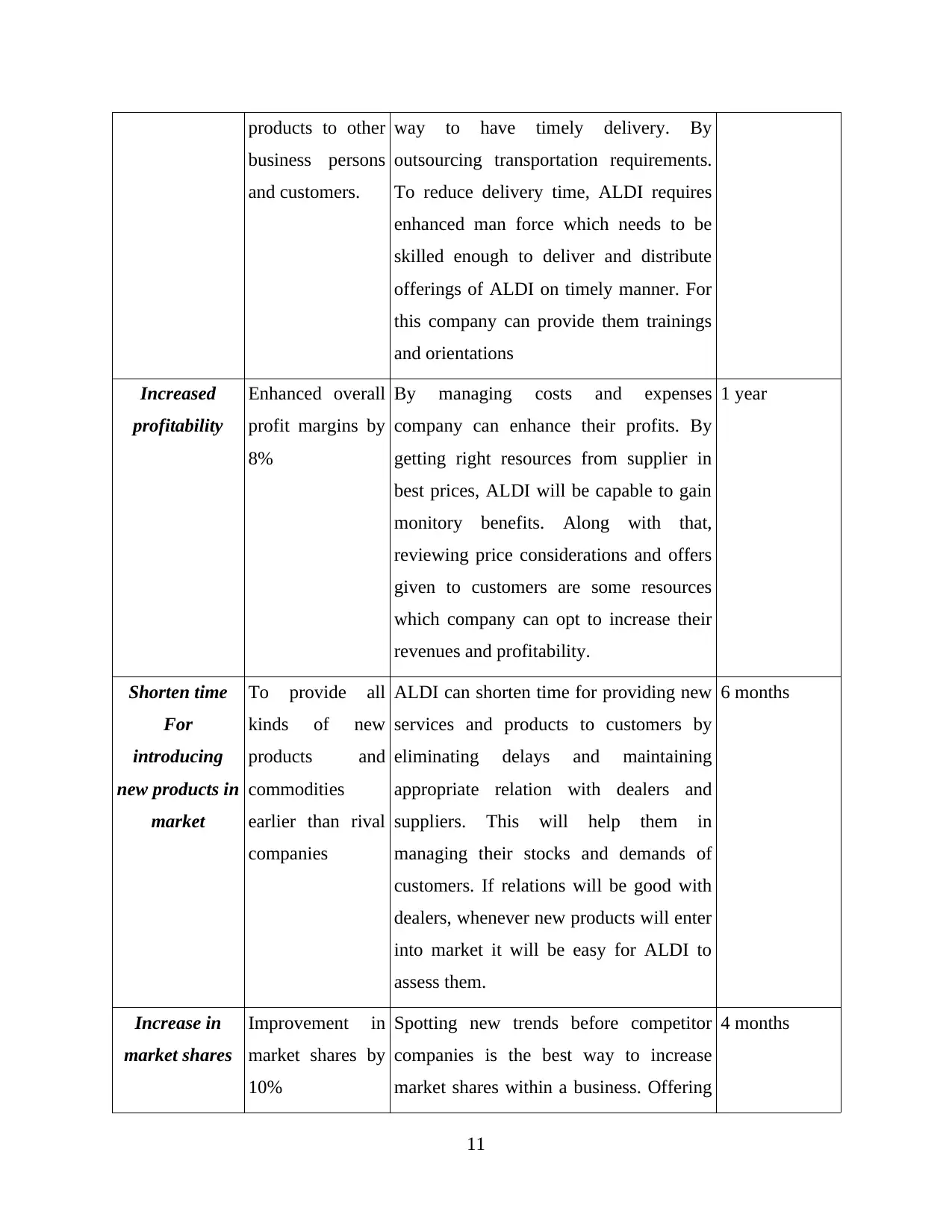
products to other
business persons
and customers.
way to have timely delivery. By
outsourcing transportation requirements.
To reduce delivery time, ALDI requires
enhanced man force which needs to be
skilled enough to deliver and distribute
offerings of ALDI on timely manner. For
this company can provide them trainings
and orientations
Increased
profitability
Enhanced overall
profit margins by
8%
By managing costs and expenses
company can enhance their profits. By
getting right resources from supplier in
best prices, ALDI will be capable to gain
monitory benefits. Along with that,
reviewing price considerations and offers
given to customers are some resources
which company can opt to increase their
revenues and profitability.
1 year
Shorten time
For
introducing
new products in
market
To provide all
kinds of new
products and
commodities
earlier than rival
companies
ALDI can shorten time for providing new
services and products to customers by
eliminating delays and maintaining
appropriate relation with dealers and
suppliers. This will help them in
managing their stocks and demands of
customers. If relations will be good with
dealers, whenever new products will enter
into market it will be easy for ALDI to
assess them.
6 months
Increase in
market shares
Improvement in
market shares by
10%
Spotting new trends before competitor
companies is the best way to increase
market shares within a business. Offering
4 months
11
business persons
and customers.
way to have timely delivery. By
outsourcing transportation requirements.
To reduce delivery time, ALDI requires
enhanced man force which needs to be
skilled enough to deliver and distribute
offerings of ALDI on timely manner. For
this company can provide them trainings
and orientations
Increased
profitability
Enhanced overall
profit margins by
8%
By managing costs and expenses
company can enhance their profits. By
getting right resources from supplier in
best prices, ALDI will be capable to gain
monitory benefits. Along with that,
reviewing price considerations and offers
given to customers are some resources
which company can opt to increase their
revenues and profitability.
1 year
Shorten time
For
introducing
new products in
market
To provide all
kinds of new
products and
commodities
earlier than rival
companies
ALDI can shorten time for providing new
services and products to customers by
eliminating delays and maintaining
appropriate relation with dealers and
suppliers. This will help them in
managing their stocks and demands of
customers. If relations will be good with
dealers, whenever new products will enter
into market it will be easy for ALDI to
assess them.
6 months
Increase in
market shares
Improvement in
market shares by
10%
Spotting new trends before competitor
companies is the best way to increase
market shares within a business. Offering
4 months
11
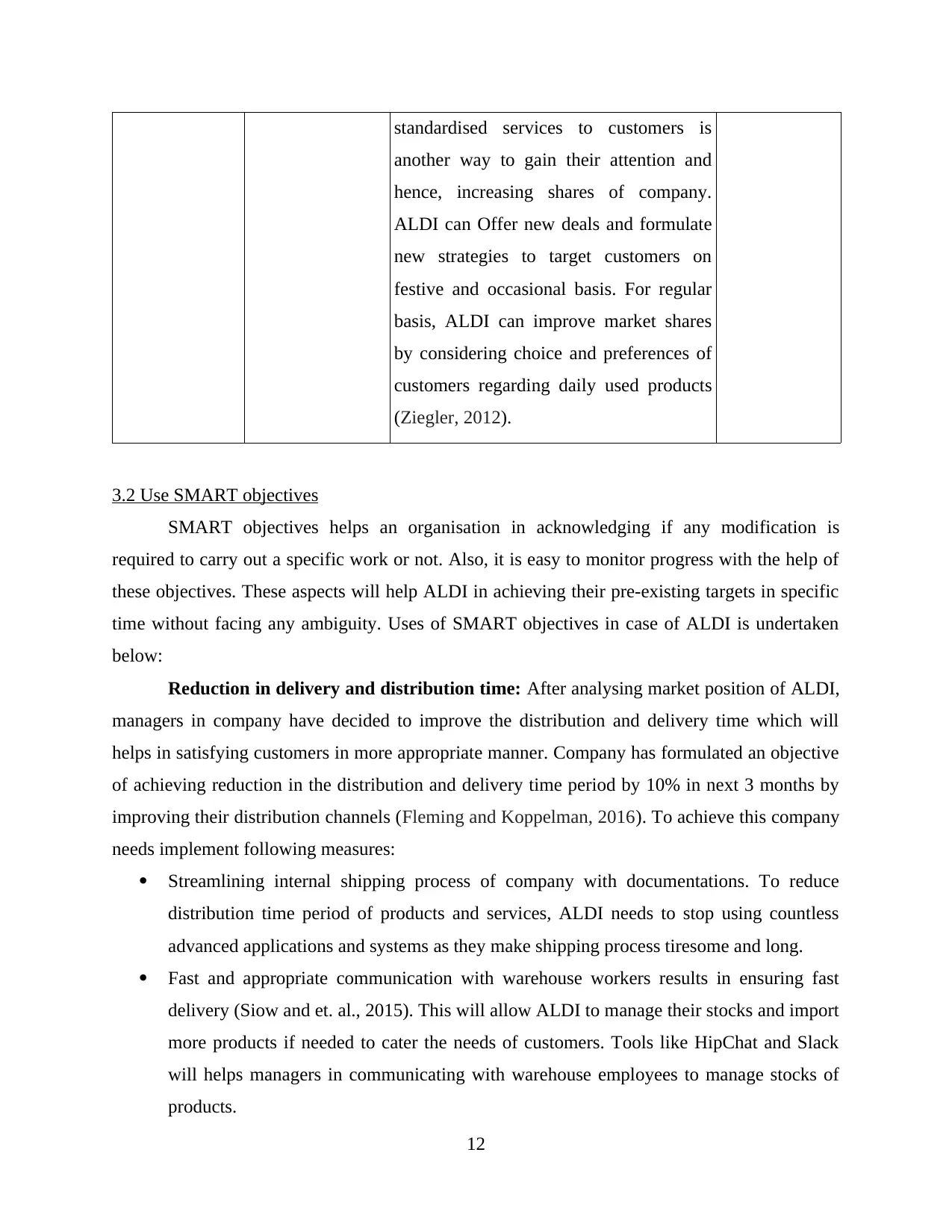
standardised services to customers is
another way to gain their attention and
hence, increasing shares of company.
ALDI can Offer new deals and formulate
new strategies to target customers on
festive and occasional basis. For regular
basis, ALDI can improve market shares
by considering choice and preferences of
customers regarding daily used products
(Ziegler, 2012).
3.2 Use SMART objectives
SMART objectives helps an organisation in acknowledging if any modification is
required to carry out a specific work or not. Also, it is easy to monitor progress with the help of
these objectives. These aspects will help ALDI in achieving their pre-existing targets in specific
time without facing any ambiguity. Uses of SMART objectives in case of ALDI is undertaken
below:
Reduction in delivery and distribution time: After analysing market position of ALDI,
managers in company have decided to improve the distribution and delivery time which will
helps in satisfying customers in more appropriate manner. Company has formulated an objective
of achieving reduction in the distribution and delivery time period by 10% in next 3 months by
improving their distribution channels (Fleming and Koppelman, 2016). To achieve this company
needs implement following measures:
Streamlining internal shipping process of company with documentations. To reduce
distribution time period of products and services, ALDI needs to stop using countless
advanced applications and systems as they make shipping process tiresome and long.
Fast and appropriate communication with warehouse workers results in ensuring fast
delivery (Siow and et. al., 2015). This will allow ALDI to manage their stocks and import
more products if needed to cater the needs of customers. Tools like HipChat and Slack
will helps managers in communicating with warehouse employees to manage stocks of
products.
12
another way to gain their attention and
hence, increasing shares of company.
ALDI can Offer new deals and formulate
new strategies to target customers on
festive and occasional basis. For regular
basis, ALDI can improve market shares
by considering choice and preferences of
customers regarding daily used products
(Ziegler, 2012).
3.2 Use SMART objectives
SMART objectives helps an organisation in acknowledging if any modification is
required to carry out a specific work or not. Also, it is easy to monitor progress with the help of
these objectives. These aspects will help ALDI in achieving their pre-existing targets in specific
time without facing any ambiguity. Uses of SMART objectives in case of ALDI is undertaken
below:
Reduction in delivery and distribution time: After analysing market position of ALDI,
managers in company have decided to improve the distribution and delivery time which will
helps in satisfying customers in more appropriate manner. Company has formulated an objective
of achieving reduction in the distribution and delivery time period by 10% in next 3 months by
improving their distribution channels (Fleming and Koppelman, 2016). To achieve this company
needs implement following measures:
Streamlining internal shipping process of company with documentations. To reduce
distribution time period of products and services, ALDI needs to stop using countless
advanced applications and systems as they make shipping process tiresome and long.
Fast and appropriate communication with warehouse workers results in ensuring fast
delivery (Siow and et. al., 2015). This will allow ALDI to manage their stocks and import
more products if needed to cater the needs of customers. Tools like HipChat and Slack
will helps managers in communicating with warehouse employees to manage stocks of
products.
12
You're viewing a preview
Unlock full access by subscribing today!
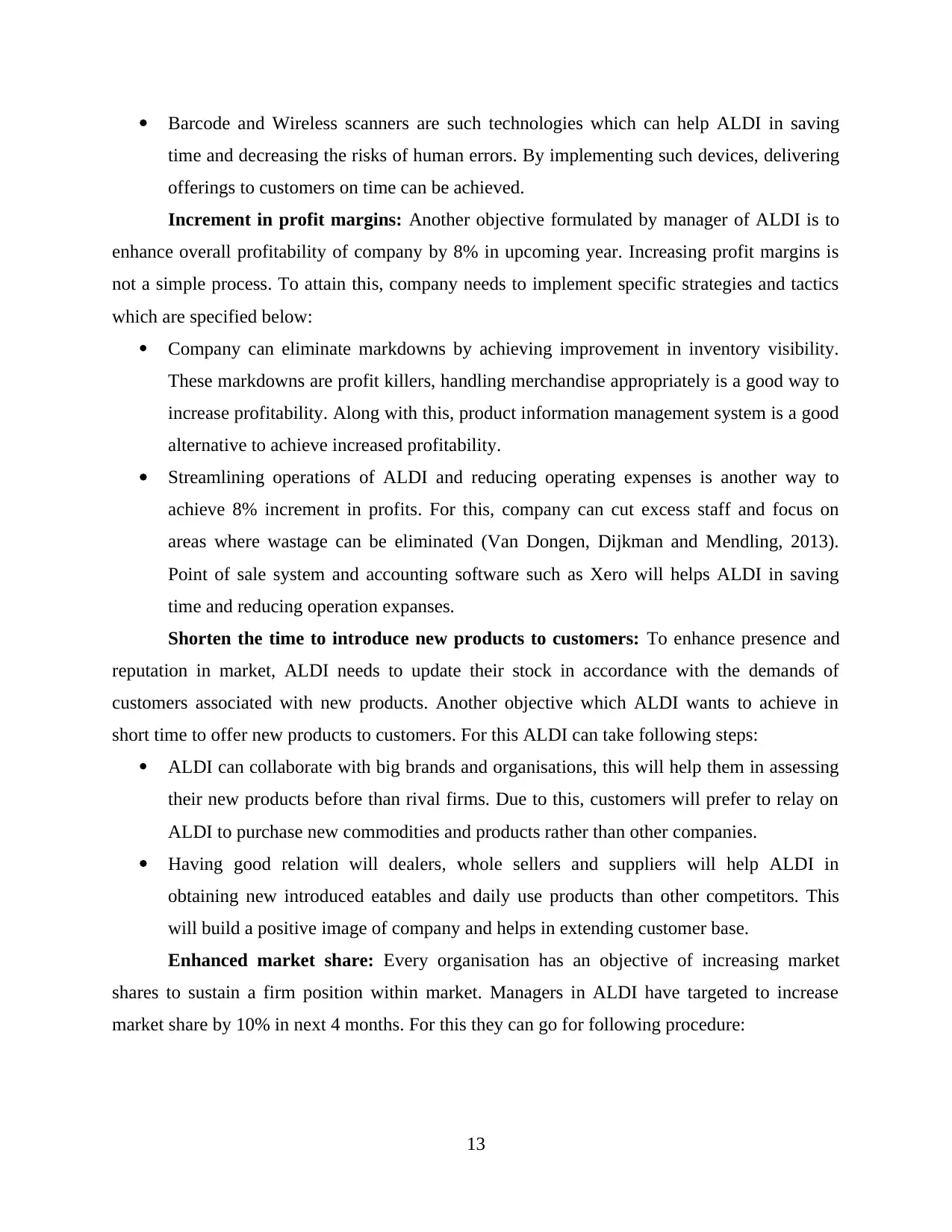
Barcode and Wireless scanners are such technologies which can help ALDI in saving
time and decreasing the risks of human errors. By implementing such devices, delivering
offerings to customers on time can be achieved.
Increment in profit margins: Another objective formulated by manager of ALDI is to
enhance overall profitability of company by 8% in upcoming year. Increasing profit margins is
not a simple process. To attain this, company needs to implement specific strategies and tactics
which are specified below:
Company can eliminate markdowns by achieving improvement in inventory visibility.
These markdowns are profit killers, handling merchandise appropriately is a good way to
increase profitability. Along with this, product information management system is a good
alternative to achieve increased profitability.
Streamlining operations of ALDI and reducing operating expenses is another way to
achieve 8% increment in profits. For this, company can cut excess staff and focus on
areas where wastage can be eliminated (Van Dongen, Dijkman and Mendling, 2013).
Point of sale system and accounting software such as Xero will helps ALDI in saving
time and reducing operation expanses.
Shorten the time to introduce new products to customers: To enhance presence and
reputation in market, ALDI needs to update their stock in accordance with the demands of
customers associated with new products. Another objective which ALDI wants to achieve in
short time to offer new products to customers. For this ALDI can take following steps:
ALDI can collaborate with big brands and organisations, this will help them in assessing
their new products before than rival firms. Due to this, customers will prefer to relay on
ALDI to purchase new commodities and products rather than other companies.
Having good relation will dealers, whole sellers and suppliers will help ALDI in
obtaining new introduced eatables and daily use products than other competitors. This
will build a positive image of company and helps in extending customer base.
Enhanced market share: Every organisation has an objective of increasing market
shares to sustain a firm position within market. Managers in ALDI have targeted to increase
market share by 10% in next 4 months. For this they can go for following procedure:
13
time and decreasing the risks of human errors. By implementing such devices, delivering
offerings to customers on time can be achieved.
Increment in profit margins: Another objective formulated by manager of ALDI is to
enhance overall profitability of company by 8% in upcoming year. Increasing profit margins is
not a simple process. To attain this, company needs to implement specific strategies and tactics
which are specified below:
Company can eliminate markdowns by achieving improvement in inventory visibility.
These markdowns are profit killers, handling merchandise appropriately is a good way to
increase profitability. Along with this, product information management system is a good
alternative to achieve increased profitability.
Streamlining operations of ALDI and reducing operating expenses is another way to
achieve 8% increment in profits. For this, company can cut excess staff and focus on
areas where wastage can be eliminated (Van Dongen, Dijkman and Mendling, 2013).
Point of sale system and accounting software such as Xero will helps ALDI in saving
time and reducing operation expanses.
Shorten the time to introduce new products to customers: To enhance presence and
reputation in market, ALDI needs to update their stock in accordance with the demands of
customers associated with new products. Another objective which ALDI wants to achieve in
short time to offer new products to customers. For this ALDI can take following steps:
ALDI can collaborate with big brands and organisations, this will help them in assessing
their new products before than rival firms. Due to this, customers will prefer to relay on
ALDI to purchase new commodities and products rather than other companies.
Having good relation will dealers, whole sellers and suppliers will help ALDI in
obtaining new introduced eatables and daily use products than other competitors. This
will build a positive image of company and helps in extending customer base.
Enhanced market share: Every organisation has an objective of increasing market
shares to sustain a firm position within market. Managers in ALDI have targeted to increase
market share by 10% in next 4 months. For this they can go for following procedure:
13
Paraphrase This Document
Need a fresh take? Get an instant paraphrase of this document with our AI Paraphraser
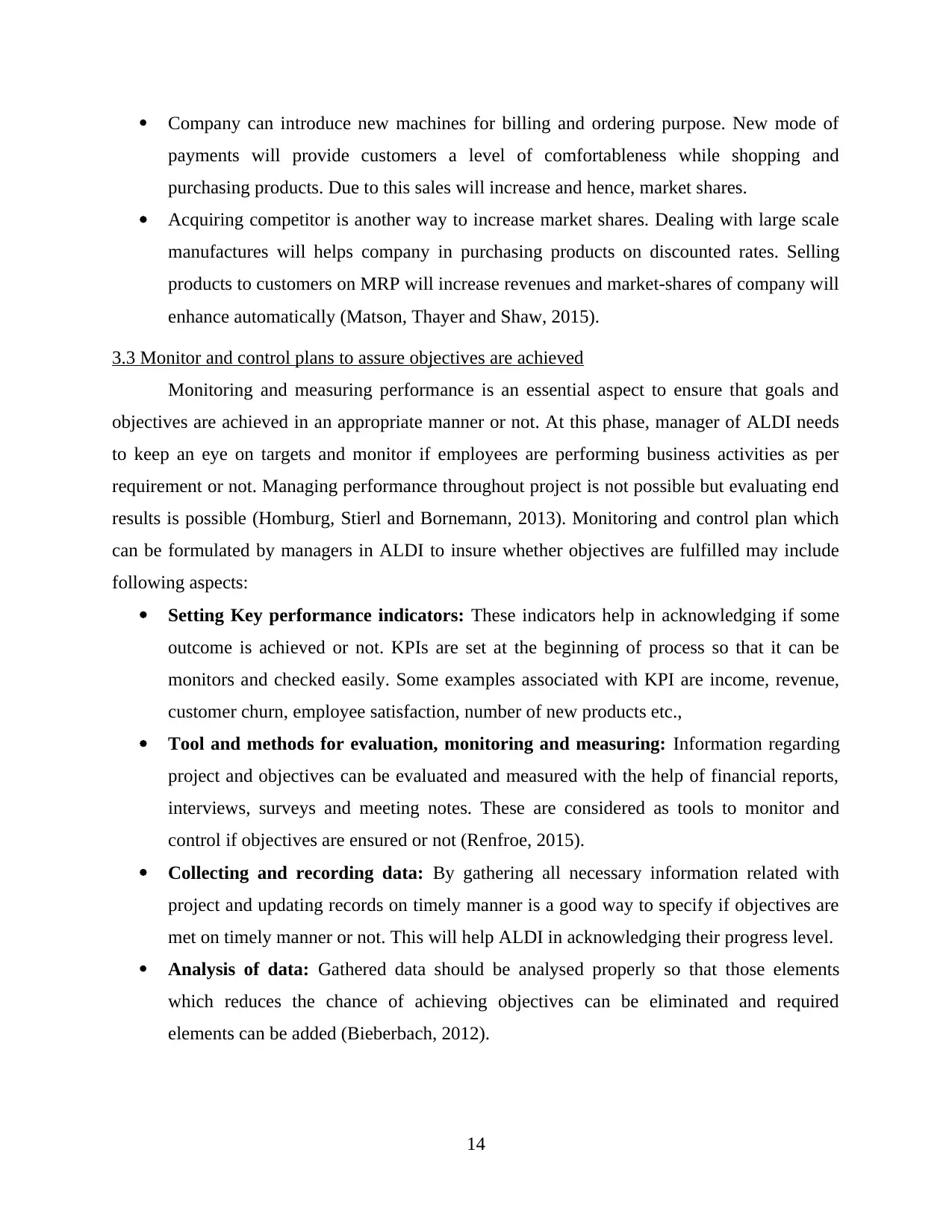
Company can introduce new machines for billing and ordering purpose. New mode of
payments will provide customers a level of comfortableness while shopping and
purchasing products. Due to this sales will increase and hence, market shares.
Acquiring competitor is another way to increase market shares. Dealing with large scale
manufactures will helps company in purchasing products on discounted rates. Selling
products to customers on MRP will increase revenues and market-shares of company will
enhance automatically (Matson, Thayer and Shaw, 2015).
3.3 Monitor and control plans to assure objectives are achieved
Monitoring and measuring performance is an essential aspect to ensure that goals and
objectives are achieved in an appropriate manner or not. At this phase, manager of ALDI needs
to keep an eye on targets and monitor if employees are performing business activities as per
requirement or not. Managing performance throughout project is not possible but evaluating end
results is possible (Homburg, Stierl and Bornemann, 2013). Monitoring and control plan which
can be formulated by managers in ALDI to insure whether objectives are fulfilled may include
following aspects:
Setting Key performance indicators: These indicators help in acknowledging if some
outcome is achieved or not. KPIs are set at the beginning of process so that it can be
monitors and checked easily. Some examples associated with KPI are income, revenue,
customer churn, employee satisfaction, number of new products etc.,
Tool and methods for evaluation, monitoring and measuring: Information regarding
project and objectives can be evaluated and measured with the help of financial reports,
interviews, surveys and meeting notes. These are considered as tools to monitor and
control if objectives are ensured or not (Renfroe, 2015).
Collecting and recording data: By gathering all necessary information related with
project and updating records on timely manner is a good way to specify if objectives are
met on timely manner or not. This will help ALDI in acknowledging their progress level.
Analysis of data: Gathered data should be analysed properly so that those elements
which reduces the chance of achieving objectives can be eliminated and required
elements can be added (Bieberbach, 2012).
14
payments will provide customers a level of comfortableness while shopping and
purchasing products. Due to this sales will increase and hence, market shares.
Acquiring competitor is another way to increase market shares. Dealing with large scale
manufactures will helps company in purchasing products on discounted rates. Selling
products to customers on MRP will increase revenues and market-shares of company will
enhance automatically (Matson, Thayer and Shaw, 2015).
3.3 Monitor and control plans to assure objectives are achieved
Monitoring and measuring performance is an essential aspect to ensure that goals and
objectives are achieved in an appropriate manner or not. At this phase, manager of ALDI needs
to keep an eye on targets and monitor if employees are performing business activities as per
requirement or not. Managing performance throughout project is not possible but evaluating end
results is possible (Homburg, Stierl and Bornemann, 2013). Monitoring and control plan which
can be formulated by managers in ALDI to insure whether objectives are fulfilled may include
following aspects:
Setting Key performance indicators: These indicators help in acknowledging if some
outcome is achieved or not. KPIs are set at the beginning of process so that it can be
monitors and checked easily. Some examples associated with KPI are income, revenue,
customer churn, employee satisfaction, number of new products etc.,
Tool and methods for evaluation, monitoring and measuring: Information regarding
project and objectives can be evaluated and measured with the help of financial reports,
interviews, surveys and meeting notes. These are considered as tools to monitor and
control if objectives are ensured or not (Renfroe, 2015).
Collecting and recording data: By gathering all necessary information related with
project and updating records on timely manner is a good way to specify if objectives are
met on timely manner or not. This will help ALDI in acknowledging their progress level.
Analysis of data: Gathered data should be analysed properly so that those elements
which reduces the chance of achieving objectives can be eliminated and required
elements can be added (Bieberbach, 2012).
14
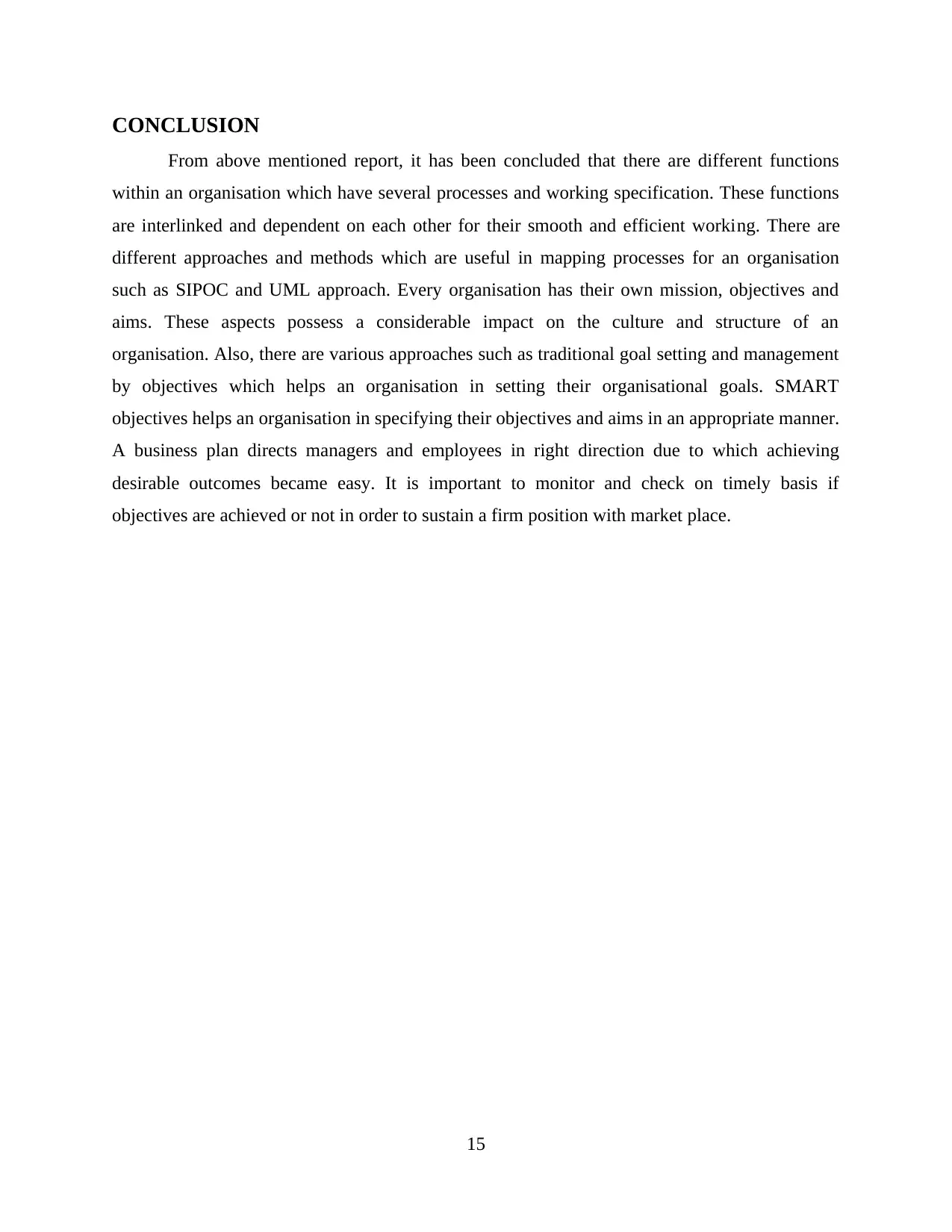
CONCLUSION
From above mentioned report, it has been concluded that there are different functions
within an organisation which have several processes and working specification. These functions
are interlinked and dependent on each other for their smooth and efficient working. There are
different approaches and methods which are useful in mapping processes for an organisation
such as SIPOC and UML approach. Every organisation has their own mission, objectives and
aims. These aspects possess a considerable impact on the culture and structure of an
organisation. Also, there are various approaches such as traditional goal setting and management
by objectives which helps an organisation in setting their organisational goals. SMART
objectives helps an organisation in specifying their objectives and aims in an appropriate manner.
A business plan directs managers and employees in right direction due to which achieving
desirable outcomes became easy. It is important to monitor and check on timely basis if
objectives are achieved or not in order to sustain a firm position with market place.
15
From above mentioned report, it has been concluded that there are different functions
within an organisation which have several processes and working specification. These functions
are interlinked and dependent on each other for their smooth and efficient working. There are
different approaches and methods which are useful in mapping processes for an organisation
such as SIPOC and UML approach. Every organisation has their own mission, objectives and
aims. These aspects possess a considerable impact on the culture and structure of an
organisation. Also, there are various approaches such as traditional goal setting and management
by objectives which helps an organisation in setting their organisational goals. SMART
objectives helps an organisation in specifying their objectives and aims in an appropriate manner.
A business plan directs managers and employees in right direction due to which achieving
desirable outcomes became easy. It is important to monitor and check on timely basis if
objectives are achieved or not in order to sustain a firm position with market place.
15
You're viewing a preview
Unlock full access by subscribing today!
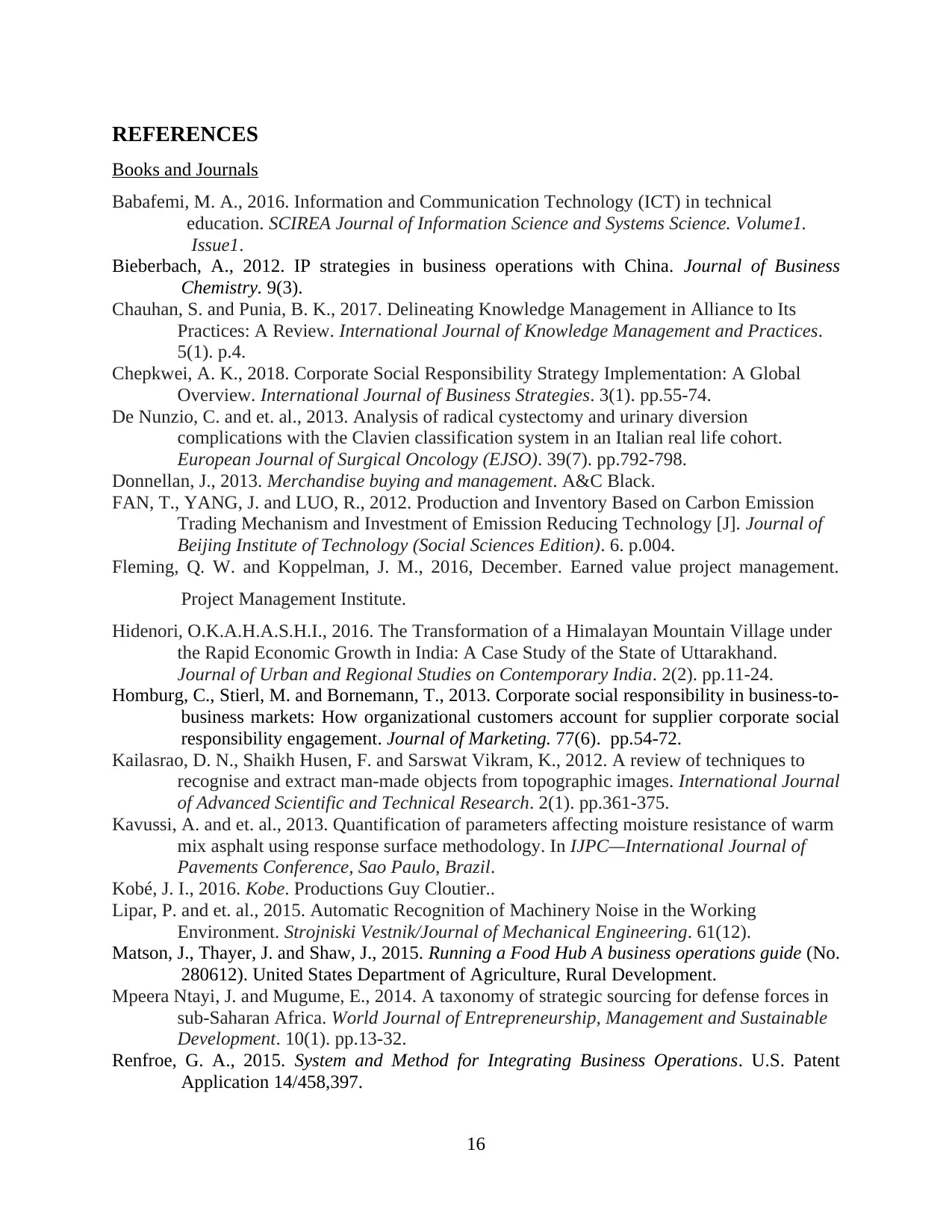
REFERENCES
Books and Journals
Babafemi, M. A., 2016. Information and Communication Technology (ICT) in technical
education. SCIREA Journal of Information Science and Systems Science. Volume1.
Issue1.
Bieberbach, A., 2012. IP strategies in business operations with China. Journal of Business
Chemistry. 9(3).
Chauhan, S. and Punia, B. K., 2017. Delineating Knowledge Management in Alliance to Its
Practices: A Review. International Journal of Knowledge Management and Practices.
5(1). p.4.
Chepkwei, A. K., 2018. Corporate Social Responsibility Strategy Implementation: A Global
Overview. International Journal of Business Strategies. 3(1). pp.55-74.
De Nunzio, C. and et. al., 2013. Analysis of radical cystectomy and urinary diversion
complications with the Clavien classification system in an Italian real life cohort.
European Journal of Surgical Oncology (EJSO). 39(7). pp.792-798.
Donnellan, J., 2013. Merchandise buying and management. A&C Black.
FAN, T., YANG, J. and LUO, R., 2012. Production and Inventory Based on Carbon Emission
Trading Mechanism and Investment of Emission Reducing Technology [J]. Journal of
Beijing Institute of Technology (Social Sciences Edition). 6. p.004.
Fleming, Q. W. and Koppelman, J. M., 2016, December. Earned value project management.
Project Management Institute.
Hidenori, O.K.A.H.A.S.H.I., 2016. The Transformation of a Himalayan Mountain Village under
the Rapid Economic Growth in India: A Case Study of the State of Uttarakhand.
Journal of Urban and Regional Studies on Contemporary India. 2(2). pp.11-24.
Homburg, C., Stierl, M. and Bornemann, T., 2013. Corporate social responsibility in business-to-
business markets: How organizational customers account for supplier corporate social
responsibility engagement. Journal of Marketing. 77(6). pp.54-72.
Kailasrao, D. N., Shaikh Husen, F. and Sarswat Vikram, K., 2012. A review of techniques to
recognise and extract man-made objects from topographic images. International Journal
of Advanced Scientific and Technical Research. 2(1). pp.361-375.
Kavussi, A. and et. al., 2013. Quantification of parameters affecting moisture resistance of warm
mix asphalt using response surface methodology. In IJPC—International Journal of
Pavements Conference, Sao Paulo, Brazil.
Kobé, J. I., 2016. Kobe. Productions Guy Cloutier..
Lipar, P. and et. al., 2015. Automatic Recognition of Machinery Noise in the Working
Environment. Strojniski Vestnik/Journal of Mechanical Engineering. 61(12).
Matson, J., Thayer, J. and Shaw, J., 2015. Running a Food Hub A business operations guide (No.
280612). United States Department of Agriculture, Rural Development.
Mpeera Ntayi, J. and Mugume, E., 2014. A taxonomy of strategic sourcing for defense forces in
sub-Saharan Africa. World Journal of Entrepreneurship, Management and Sustainable
Development. 10(1). pp.13-32.
Renfroe, G. A., 2015. System and Method for Integrating Business Operations. U.S. Patent
Application 14/458,397.
16
Books and Journals
Babafemi, M. A., 2016. Information and Communication Technology (ICT) in technical
education. SCIREA Journal of Information Science and Systems Science. Volume1.
Issue1.
Bieberbach, A., 2012. IP strategies in business operations with China. Journal of Business
Chemistry. 9(3).
Chauhan, S. and Punia, B. K., 2017. Delineating Knowledge Management in Alliance to Its
Practices: A Review. International Journal of Knowledge Management and Practices.
5(1). p.4.
Chepkwei, A. K., 2018. Corporate Social Responsibility Strategy Implementation: A Global
Overview. International Journal of Business Strategies. 3(1). pp.55-74.
De Nunzio, C. and et. al., 2013. Analysis of radical cystectomy and urinary diversion
complications with the Clavien classification system in an Italian real life cohort.
European Journal of Surgical Oncology (EJSO). 39(7). pp.792-798.
Donnellan, J., 2013. Merchandise buying and management. A&C Black.
FAN, T., YANG, J. and LUO, R., 2012. Production and Inventory Based on Carbon Emission
Trading Mechanism and Investment of Emission Reducing Technology [J]. Journal of
Beijing Institute of Technology (Social Sciences Edition). 6. p.004.
Fleming, Q. W. and Koppelman, J. M., 2016, December. Earned value project management.
Project Management Institute.
Hidenori, O.K.A.H.A.S.H.I., 2016. The Transformation of a Himalayan Mountain Village under
the Rapid Economic Growth in India: A Case Study of the State of Uttarakhand.
Journal of Urban and Regional Studies on Contemporary India. 2(2). pp.11-24.
Homburg, C., Stierl, M. and Bornemann, T., 2013. Corporate social responsibility in business-to-
business markets: How organizational customers account for supplier corporate social
responsibility engagement. Journal of Marketing. 77(6). pp.54-72.
Kailasrao, D. N., Shaikh Husen, F. and Sarswat Vikram, K., 2012. A review of techniques to
recognise and extract man-made objects from topographic images. International Journal
of Advanced Scientific and Technical Research. 2(1). pp.361-375.
Kavussi, A. and et. al., 2013. Quantification of parameters affecting moisture resistance of warm
mix asphalt using response surface methodology. In IJPC—International Journal of
Pavements Conference, Sao Paulo, Brazil.
Kobé, J. I., 2016. Kobe. Productions Guy Cloutier..
Lipar, P. and et. al., 2015. Automatic Recognition of Machinery Noise in the Working
Environment. Strojniski Vestnik/Journal of Mechanical Engineering. 61(12).
Matson, J., Thayer, J. and Shaw, J., 2015. Running a Food Hub A business operations guide (No.
280612). United States Department of Agriculture, Rural Development.
Mpeera Ntayi, J. and Mugume, E., 2014. A taxonomy of strategic sourcing for defense forces in
sub-Saharan Africa. World Journal of Entrepreneurship, Management and Sustainable
Development. 10(1). pp.13-32.
Renfroe, G. A., 2015. System and Method for Integrating Business Operations. U.S. Patent
Application 14/458,397.
16
Paraphrase This Document
Need a fresh take? Get an instant paraphrase of this document with our AI Paraphraser
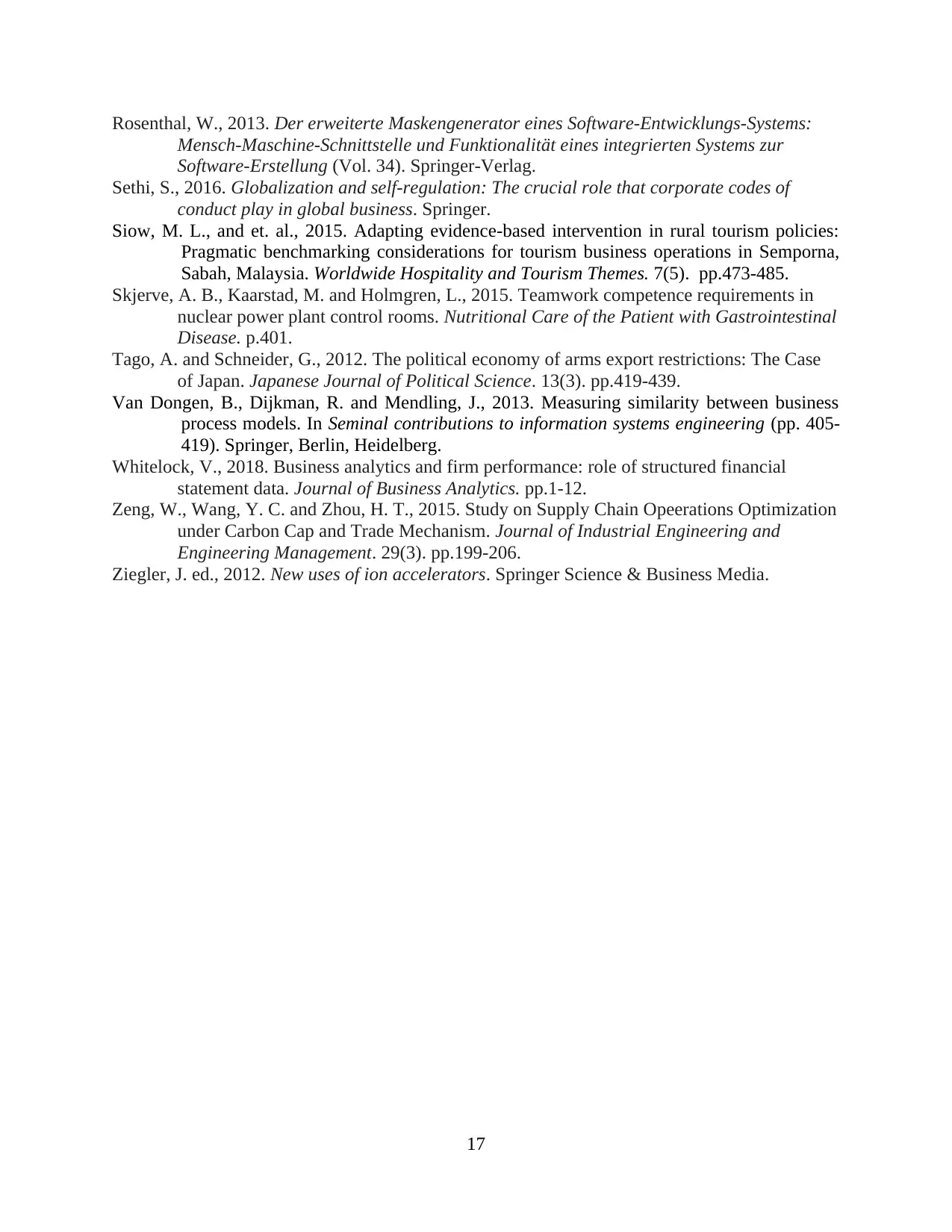
Rosenthal, W., 2013. Der erweiterte Maskengenerator eines Software-Entwicklungs-Systems:
Mensch-Maschine-Schnittstelle und Funktionalität eines integrierten Systems zur
Software-Erstellung (Vol. 34). Springer-Verlag.
Sethi, S., 2016. Globalization and self-regulation: The crucial role that corporate codes of
conduct play in global business. Springer.
Siow, M. L., and et. al., 2015. Adapting evidence-based intervention in rural tourism policies:
Pragmatic benchmarking considerations for tourism business operations in Semporna,
Sabah, Malaysia. Worldwide Hospitality and Tourism Themes. 7(5). pp.473-485.
Skjerve, A. B., Kaarstad, M. and Holmgren, L., 2015. Teamwork competence requirements in
nuclear power plant control rooms. Nutritional Care of the Patient with Gastrointestinal
Disease. p.401.
Tago, A. and Schneider, G., 2012. The political economy of arms export restrictions: The Case
of Japan. Japanese Journal of Political Science. 13(3). pp.419-439.
Van Dongen, B., Dijkman, R. and Mendling, J., 2013. Measuring similarity between business
process models. In Seminal contributions to information systems engineering (pp. 405-
419). Springer, Berlin, Heidelberg.
Whitelock, V., 2018. Business analytics and firm performance: role of structured financial
statement data. Journal of Business Analytics. pp.1-12.
Zeng, W., Wang, Y. C. and Zhou, H. T., 2015. Study on Supply Chain Opeerations Optimization
under Carbon Cap and Trade Mechanism. Journal of Industrial Engineering and
Engineering Management. 29(3). pp.199-206.
Ziegler, J. ed., 2012. New uses of ion accelerators. Springer Science & Business Media.
17
Mensch-Maschine-Schnittstelle und Funktionalität eines integrierten Systems zur
Software-Erstellung (Vol. 34). Springer-Verlag.
Sethi, S., 2016. Globalization and self-regulation: The crucial role that corporate codes of
conduct play in global business. Springer.
Siow, M. L., and et. al., 2015. Adapting evidence-based intervention in rural tourism policies:
Pragmatic benchmarking considerations for tourism business operations in Semporna,
Sabah, Malaysia. Worldwide Hospitality and Tourism Themes. 7(5). pp.473-485.
Skjerve, A. B., Kaarstad, M. and Holmgren, L., 2015. Teamwork competence requirements in
nuclear power plant control rooms. Nutritional Care of the Patient with Gastrointestinal
Disease. p.401.
Tago, A. and Schneider, G., 2012. The political economy of arms export restrictions: The Case
of Japan. Japanese Journal of Political Science. 13(3). pp.419-439.
Van Dongen, B., Dijkman, R. and Mendling, J., 2013. Measuring similarity between business
process models. In Seminal contributions to information systems engineering (pp. 405-
419). Springer, Berlin, Heidelberg.
Whitelock, V., 2018. Business analytics and firm performance: role of structured financial
statement data. Journal of Business Analytics. pp.1-12.
Zeng, W., Wang, Y. C. and Zhou, H. T., 2015. Study on Supply Chain Opeerations Optimization
under Carbon Cap and Trade Mechanism. Journal of Industrial Engineering and
Engineering Management. 29(3). pp.199-206.
Ziegler, J. ed., 2012. New uses of ion accelerators. Springer Science & Business Media.
17
1 out of 20
Related Documents
Your All-in-One AI-Powered Toolkit for Academic Success.
+13062052269
info@desklib.com
Available 24*7 on WhatsApp / Email
![[object Object]](/_next/static/media/star-bottom.7253800d.svg)
Unlock your academic potential
© 2024 | Zucol Services PVT LTD | All rights reserved.





